#the set up of multiple characters possible development was unprecedented
Explore tagged Tumblr posts
Text
Discover the Revolutionary Capabilities of Luma AI Photon

Luma AI has taken a giant leap forward with the introduction of Luma AI Photon, a cutting-edge text-to-image foundation model. This innovative technology is transforming the creative landscape, allowing users to generate captivating images at unprecedented speeds. With its advanced features and user-friendly interface, Luma AI Photon is set to change the way we approach design and creativity.
Speed and Efficiency: An Unparalleled Advantage
One of the most impressive aspects of Luma AI Photon is its speed. Utilizing Luma AI’s proprietary Universal Transformer architecture, the Photon model delivers results that are up to 800% faster than other comparable models. This means that users can create stunning, high-quality images in just a matter of seconds, freeing up valuable time to focus on the creative process. Advanced Text Rendering for Seamless Integration Another standout feature is Photon’s state-of-the-art text rendering capabilities. Users can expect accurate and precise text integration, even in complex designs. Gone are the days of common errors in text-based images; Luma AI Photon ensures that every word is perfectly placed, making it a must-have tool for designers and creatives alike.
Unlocking Creative Possibilities with Multi-Image Prompting
This revolutionary model also supports multi-image prompting. Users can easily combine multiple images to create refined outputs while maintaining stylistic consistency. This feature is especially useful for projects that require consistent character design and adaptive style generations, perfect for animations and visual campaigns. Versatility in Creative Media - Text-to-image generation - Text-to-video and image-to-video transformations - Applications across music, film, graphic design, architecture, and fashion This multimodal support positions Photon as a powerful resource for a variety of creative industries, fostering a new level of innovation.
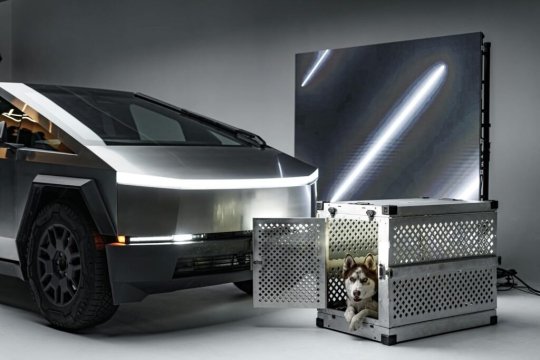
Photo by Impact Dog Crates on Pexels
Integration with Luma Dream Machine: A Seamless Workflow
The integration of Luma AI Photon within the Luma Dream Machine platform adds another layer of functionality. With the latest update to version 1.6, users can organize, refine, and execute their ideas using various tools such as artboards, storyboards, and moodboards. New features like consistent character creation and video tools with camera motion control make this platform a versatile space for all creators.
Subscription Plans for Everyone
Luma AI has made access to advanced generative AI more convenient than ever with four subscription tiers designed for a diverse user base: - $9.99 - Hobbyists - $29.99 - Explorers - $99.99 - Professionals - Enterprise Tier - For larger teams With over 25 million registered users, Luma AI ensures that both professionals and hobbyists can leverage the power of Luma AI Photon.
Future Developments: API and Developer Integration
Community and developers looking to harness Photon's capabilities can look forward to the Photon Image API, set to launch in December 2024. This API will allow developers to integrate these state-of-the-art features into their applications—offering rapid global scaling, dedicated support, and privacy assurances for input and output data.
Revolutionizing Creativity: Luma AI's Vision and Commitment
Luma Labs, co-founded by Amit Jain, aims to empower creativity through innovative AI tools. The debut of Luma AI Photon aligns perfectly with their vision of democratizing creativity, positioning them as a competitor in the generative AI space alongside industry giants like OpenAI, Google DeepMind, and Stability AI. In summary, Luma AI Photon is not just a leap forward in technology; it is an invitation to unleash creativity like never before. With remarkable speed, precision, and versatility, this groundbreaking tool paves the way for creators across all industries. Whether you are a designer, filmmaker, or someone with creative aspirations, Luma AI Photon offers the resources you need to turn your visions into reality. Have thoughts on Luma AI Photon? Feel free to leave a comment below! Don't forget to share this article with your friends who are eager to explore the future of generative AI! For more insights and updates, visit FROZENLEAVES NEWS. ``` Read the full article
0 notes
Text
I'm finally watching the Cube sequels (also was very excited to learn there was an overseas remake made last year, i had no idea) and I'm finding that my issue with Hypercube so far, aside from the relatively unimpressive acting on many parts, is that it's attempting in some ways to grasp the original concepts presented in the first film while also trying to 'improve' on the cube and it's functionality in ways that are unnecessary and overblown.
I went into things knowing that the general consensus is that this movie doesn't match up at all to the first in terms of quality. I still have to admit I'm impressed with how much it fails to *actually* impress me. The introduction of Izon and a slew of fictional physicists and hackers only adds to the frankly unpredictable rush of developments in dangers this version of the cube presents. We've jumped wildly from the plausible version of the cube- while large and unknown in origin, this creation works in ways that can happen theoretically and is realistic in scale given the correct location to build it- to a version of the cube that's unprecedented in scope: The place is infinite in possible size and relies on completely theoretical math and ideas and puts them to use unrealistically at that (in a 'hypercube' of possibly infinite size, based on how everything else works, it doesn't make as much sense that you could ever come to the same room someone else has, let alone that only after an hour into the movie do they find rooms that contain their own traps and things such as variable time speed as it's implied they spend nearly a day or so by the time it comes to pass. Arguably this is solved by the 'shrinking' of the cube but it's really not as when this is shown as a concept multiple rooms meld together but not all the things from multiple rooms do so nor does this appear to be the case elsewhere, only in the room Kate and Sasha end in which would be a very weird coincidence if it weren't kinda lazy instead), things such as the strange shape that grew from nothing without any precedent and didn't appear to have any clear pattern until the moment it did right before it disappeared, and the multiple realities that develop without an apparent trigger, and even still the 'implosion' of the cube as a concept not making any sense as there's nothing at least I'm aware of that would make this both possible and stable (in the sense that it functions as intended) in the first place and yet keep it constantly (theoretically) imploding on itself.
There's also the point that they set up similar character archetypes from the first movie to the next, removing a lot of possibilities for characters to have their own identities. Simon is nearly identical to Quentin in the course of his actions and their degradation, Max is your standard nerd a la Leaven, Sasha is the stand-in for Kazan as the exceptionally smart but otherwise impaired character, Kate is Holloway the bleeding heart and doctor, and I suppose Worth would be Jerry in how he created something for the cube but never truly knew the scope.
Spoilers for the ending, i suppose, but the reveal of Kate being an agent for Izon once she (alone) leaves the cube is... troubling. Not because of the obvious fact that who would suspect it but also because it makes no fucking sense. Bear with me: Kate is hired by Izon to enter the hypercube to locate Sasha (revealed later on to be a hacker who fled into the cube with information about Izon that is Not Great for their public image, moreso than being a weapons manufacturer is, i GUESS) and tasked to retrieve Sasha's necklace which contains the pertinent information on these goings-on. However, upon entering the hypercube Kate appears to remember nothing. It is possible that she is an exceptional actress as would be indicated by the fact that she takes Sasha's necklace without Sasha herself indicating that anything is stored on the pendent but i personally find that that makes little sense. Sasha is blind and at a severe disadvantage within the cube as evidenced by the fact that she has to be guided to move from room to room and even climb the ladders. Even for a person with no skill at fighting in any way it wouldn't be hard to just take her necklace and run. Pretending to befriend Sasha up until the end, as shown in some parallel timelines by the fact that their corpses are together and resting in comforting positions, isn't prudent for an operation such as this. Even considering the possibility of Sasha running into other versions of Kate and distrusting them, there is equal if not greater possibility of this not being an issue at all especially if she only took the necklace and never spoke or indicated who she was to any extent as Sasha is still blind and wouldn't know the difference. AGAIN there is the possibility that this did occur in some timeline but the whole thing is stupid anyway. Despite time working strangely and not making any sense in general to the point of extensive time spent in a room where things are sped up resulting in the rapid death and decomposition of two characters, all watches still line up to the same time and the cube implodes at the exact time it is meant to. I'm not a theoretical mathematician or physicist but something about this doesn't seem plausible once you start to parse it out, time both being perfectly in line with reality across realities but also moving in ways that are out of the ordinary and would put you outside of the presented time. If it weren't for the fact that there is shown to be time and reality altering qualities to the cube I would be satisfied with the answer of it all existing in a vacuum, but that's not the case.
I could give this film the benefit of the doubt on all of it's time and reality fuckery and all in all it still wouldn't amount to a good film anyway. The science is too complex and theoretical and there's too many theories and assumptions at work, as well as the really wild idea of saying 'a collapsing tesseract will grow beams of idk some goo that will take your head off or a wall of the same that will burn you up or just ehhhh make a weird growing mini tesseract inside itself that responds to your movement and shreds you and will appear only once for no apparent reason?' with your whole chest and making a movie with all that. It also hamfists the same concept of capitalism, the military industrial complex, and anyone with too much money or unfounded power making the lives of anyone just trying to get by miserable by creating an in universe villain to point fingers at and call the big evil because apparently the concept of 'society as it is today is killing everyone slowly and singling out some to kill faster for whatever reason it sees fit for the day' just wasn't terrifying enough alongside being trapped in the murderdeath cube and you need a solid name for your horror to really be scared of it. I'm positively dead on my feet over the fact that the original cube was a hulking monstrosity of a mechanical engineering marvel, too large to ignore and very difficult to ignore in its machinations even from a distance within the structure, making it the most tasty fucking metaphor for the machine of society and the way things Work while also putting the idea down to its most base of elements. And this one is a tesseract because well... just lookit it. Ain't it neat with all it's... dimensions... and murderous qualities...
Add on the cgi that's far too ambitious for what it tries to accomplish, a drained aesthetic even going up against the original and all the cube's victims wearing the same uniform, and characters that mimic their symbolic predecessors but with far less grace than can truly be forgiven- not to mention Sasha's character as a whole being a travesty between her use of the r-slur while being disabled herself (wow she must be one of the good kind of disabled people, take notes audience: she can't see but she hates the disabled just like you!) and being completely helpless for the entire movie despite being some bigshot hacker and cyber warrior who's taken down stock markets and wars against the military industrial complex. Having conceivably been blind her entire life or even a long time you would think she'd have adapted to some extent (and also maybe wouldn't have entered a theoretical murder shape without a mobility device if not) and with everything else she would have some grace under pressure in some capacity. While Kazan is put down by the majority of characters in Cube only to be revealed to be the secret to their survival as a math whiz, at the very least he does serve some real purpose to the plot and it's underlying messages, while Cube 2 puts Sasha down as only the means to a bullshit ending (and beginning, having given Izon the tools to create the tesserect for some god forsaken reason) and then kills her as soon as her big reveal has come to pass and she's had her moment as anything other than 'the blind girl that's had to be guided this entire time just to survive'.
To summarize: Yet another piss poor excuse for a sequel and not worth your time unless you really like bullshit theoretical physics and math done poorly.
#cube#cube 2 hypercube#media talk#god but this was a disappointing one#*yells from the audience* you can't even parallel your characters correctly!#spiced#i refuse to put myself under a read more you read it all you scroll past or you unfollow me i do not compromise here#look at me go insane over a movie i didn't enjoy watching and revel in my disdain
2 notes
·
View notes
Text
HERBERT WEST CHEAT SHEET !
since my muses are not super well known in the contemporary rpc ( and i’m too lazy to do a full about page at this very moment ) i decided to put together little posts for them that give their general backgrounds, vibes, and plot possibilities !
this is a mix of canon and headcanon, and these are subject to change / adapt as i get more used to writing the characters
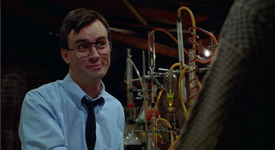
BACKGROUND:
Films: Re-Animator 1985, Bride of Re-Animator 1990, Beyond Re-Animator 2003
We don’t talk about Beyond Re-Animator......
Dr. Herbert West, 24 in the first movie, 27 in the second movie, idk like 40 in the third movie. Mad scientist to the MAX. In the novelization Herbert is an orphan who gets passed around in foster homes before eventually going to undergrad at NYU and pursuing his theory about the re-animation of dead tissue. Mostly people think he’s sort of crazy until one of his articles catches the eye of Dr. Hans Gruber at a university in Switzerland, and he invites Herbert to come work alongside him. Herbert eventually grows to respect Gruber as both a mentor and father-figure.
Herbert and Gruber develop a reagent that affects re-animation in dead animal tissue but they know that for their results to be taken seriously they need to do a human trial. Dr. Gruber volunteers but the dosage of the reagent is too large, and though it brings Gruber back to life it quickly overwhelms his system and he dies again. Herbert is taken into psychiatric custody in Switzerland but is eventually released.
Herbert returns to America and specifically sets his sights on Miskatonic Medical School in Arkham, Massachusetts because one of the staff, Dr. Carl Hill, used to work with Gruber years ago, and even went on to plagiarize some of Gruber’s work and publish it in America. Herbert makes it his secondary goal to absolutely terrorize Dr. Hill, and because he’s a chaotic gremlin in human form he’s very good at it.
Herbert continues working on perfecting the reagent, rooming with Dan Cain and eventually pulling Dan into the experiments as well when Dan’s cat dies and Herbert is able to prove his research by reanimating it. Herbert isn’t perturbed when Dan’s talk with Dean Halsey goes south, and just digs his heels in and insists that the only way to truly prove that the reagent works is to reanimate a human cadaver.
Results are just as bad as you��d expect. Sure, the cadaver reanimates but it also wrecks the morgue and kills Dean Halsey. RIP. Herbert insists that they reanimate him and the dean comes back less like himself and more animalistic, trying to kill both Herbert and Dan before his daughter Meg shows up and stops him. Despite it all, Herbert manages to wriggle his and Dan out of any suspicion from the police but Dr. Hill takes an interest in Herbert’s work once he does exploratory surgery of Dean Halsey and finds out he’s technically dead.
Dr. Hill confronts Herbert in his laboratory and threatens to steal Herbert’s work and take it for his own, offering Herbert the meager honour of being his assistant. Herbert promptly murders Hill via decapitation but decides not to let his fresh corpse go to waste and reanimates both Hill’s head and his body, which come back to life and knock Herbert out and steal all of his work.
Yada yada, Herbert gets Dan to help him go after Hill, the big climax happens. Herbert is able to prove his theory about overdose by shooting up Dr. Hill’s headless body with a bunch of reagent, which backfires and Herbert is left for dead all tangled up in Hill’s intestines, but not after he ensures that his research is safe with Dan.
They never explain how Herbert survives the first movie but he sure is alive in the second movie! It’s roughly 3ish years after the first film, so he’s got his doctorate now and he’s drug Dan all the way to Peru so they can be volunteer medics in a civil war. This obviously gives Herbert an unprecedented access to fresh bodies for his experiments.
Eventually he and Dan head back to Miskatonic Hospital, where they’re able to get jobs and a creepy cute little house that used to be a mortuary so they can continue the work. Herbert is now obsessed with the reanimation of separate parts and convinces Dan to help him build an entirely new life from parts. Dan’s not on board until Herbert shows him Megan Halsey’s heart and promises that they’ll build the body around it.
Dr. Hill’s head also somehow survived the first movie and it tries to terrorize Herbert, along with a cop who’s investigating Herbert for stealing corpses. Herbert eventually kills and reanimates the cop, and then gets into even more trouble when all of the other strange creatures he’s been reanimating start coming after him because they’re being mind controlled by Dr. Hill’s nasty head ( don’t ask me okay, this script was written in literally 6 weeks it makes no sense )
Anyway Herbert and Dan successfully bring their creation to life right before getting attacked by Dr. Hill and his army of weirdos, all while Dan is having a mental breakdown because he thinks the creation is his dead girlfriend Meg. In the chaos Dan and the creation escape separately while Herbert and Hill and co. get trapped under buried rubble and are left for dead ( AGAIN ).
But surprise! Herbert isn’t dead! We don’t know how he survived but we do know that at some point in time Dan turned over evidence to the authorities that led to Herbert’s arrest and imprisonment. The third movie picks up with Herbert who’s been in prison for 13 years and the dumbass new hospital doctor is a fanboy of Herbert and brings in some of his reagent. Herbert basically starts a prison riot, chaos ensues, this movie is Not Good, but the important thing is that Herbert escapes prison with his work and gets to walk off free and definitely alive into the night <3
VIBES / PERSONALITY:
His work is EVERYTHING to him -- there have been multiple times where Herbert has put his work above his own bodily safety or chance of survival, and I guarantee he would do it again, too. Herbert is mostly focused on being able to do the impossible simply because it’s “impossible.” He’s able to convince Dan to help him because he reasons the practical applications of his reagent, like saving lives by aiding in surgeries or helping with amputations, but at the end of the day Herbert is only concerned with discovery, acclaim, and giving classical science a big ‘ole middle finger.
He can be incredibly manipulative when looking for a specific action or behavior in the people close to him. This mostly is seen in how he treats Dan, often reeling him back in with promise of how much good their work will do in the world when Dan starts to get squeamish. Herbert is also really good at finding the sorest spots in someone and pressing on them, but usually only does this when he wants to prove a point or if he really hates someone.
He gains a lot of power by seeming like the more “level-headed” person in an altercation, but he can get extremely excitable or aggressive, especially when something goes well with his research or if it’s being threatened.
He’s genuinely a good doctor, doesn’t freak out under pressure, has neutral-good bedside manner, is very decisive and isn’t afraid to make difficult decisions when it comes to a patient’s life. However, Herbert considers himself a scientist first and a doctor second. The work on reanimation will always come before anything else.
He’s a HUGE fucking nerd, he loves making puns or little zingers whenever he can fit them into a conversation. He also likes playing practical jokes, though he doesn’t do it often. He’s got a great evil giggle.
Oh he’s terrible at taking care of himself. There’s a deleted scene from the first movie where Herbert is shown to be injecting himself with a weakened version of the reanimating reagent because it helps keep his brain sharp and makes it to where he doesn’t have to sleep. What a NUT. I think he probably weans off this habit, by force or choice. His sleeping and eating habits are still pretty bad, though. Definitely the kind of person who doesn’t eat/sleep/rest unless he’s genuinely about to collapse because of it.
Oh he’s also sooooooooooo gay. gay gay gay homo sexual.
There are very few people he outright respects or enjoys spending time around, and with everyone else he is absolutely so bitchy and rude. He doesn’t give a single shit about being polite. Also ACAB.
PLOT POSSIBILITIES:
Got any canonically dead muses? Want them to be alive again? Herbert can help with that! He’ll definitely want to make sure they stick around and observe them to see why the reagent worked so well, maybe do some extra tests, so he can also double as a really annoying, creepy roommate. Score!
Med student muses? I have a new classmate for you
Ever wondered what your muse would do if they saw someone graverobbing, or smuggling body parts into their house in the middle of the night? Do they stop him? Ask questions? Offer to help? Now’s the chance to find out!
He could always use a new assistant since Dan keeps abandoning him after every movie, jfc, loyalty is so hard to find these days
Meet-cute where one of his reanimated creations tries to murder you and he saves you from it <3
#( SAVE TAG: H. WEST. )#ooc#this one especially is very infodumpy#i think that's why i was putting it off cuz i knew it was gonna be long a;lskfjda#herbert is the reason i started this blog..... i love this little bitch so much....#not even sure if this is coherent besties !
10 notes
·
View notes
Text
Fantastic (but long) article about Theater of War’s recent productions, including Oedipus the King and Antigone in Ferguson, featuring Oscar Isaac. The following are excerpts. The full article is viewable via the source link below:
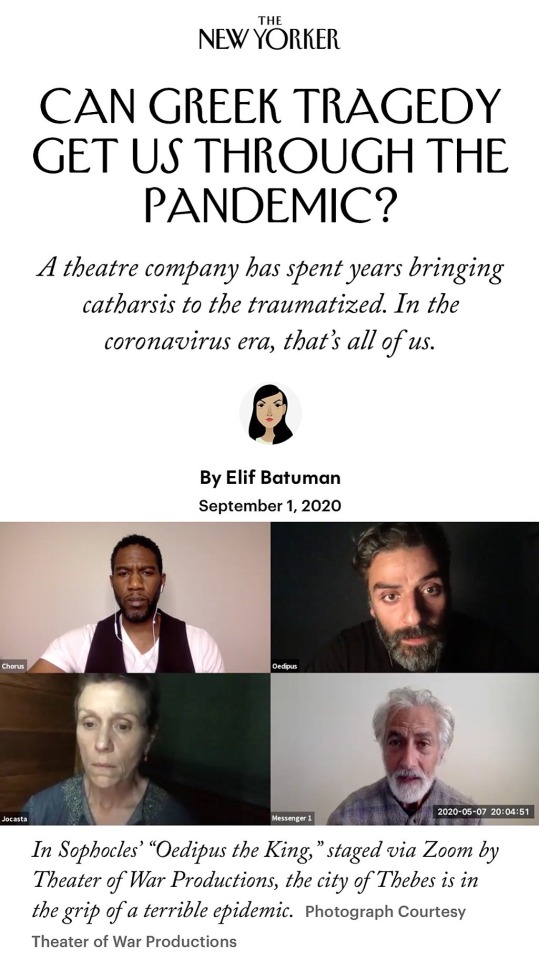
Excerpt:
“Children of Thebes, why are you here?” Oscar Isaac asked. His face filled the monitor on my dining table. (It was my partner’s turn to use the desk.) We were a couple of months into lockdown, just past seven in the evening, and a few straggling cheers for essential workers came in through the window. Isaac was looking smoldery with a quarantine beard, a gold chain, an Airpod, and a black T-shirt. His display name was set to “Oedipus.”
Isaac was one of several famous actors performing Sophocles’ “Oedipus the King” from their homes, in the first virtual performance by Theater of War Productions: a group that got its start in 2008, staging Sophocles’ “Ajax” and “Philoctetes” for U.S. military audiences and, beginning in 2009, on military installations around the world, including in Kuwait, Qatar, and Guantánamo Bay, with a focus on combat trauma. After each dramatic reading, a panel made up of people in active service, veterans, military spouses, and/or psychiatrists would describe how the play resonated with their experiences of war, before opening up the discussion to the audience. Since its founding, Theater of War Productions has addressed different kinds of trauma. It has produced Euripides’ “The Bacchae” in rural communities affected by the opioid crisis, “The Madness of Heracles” in neighborhoods afflicted by gun violence and gang wars, and Aeschylus’ “Prometheus Bound” in prisons. “Antigone in Ferguson,” which focusses on crises between communities and law enforcement, was motivated by an analogy between Oedipus’ son’s unburied body and that of Michael Brown, left on the street for roughly four hours after Brown was killed by police; it was originally performed at Michael Brown’s high school.
Now, with trauma roving the globe more contagiously than ever, Theater of War Productions had traded its site-specific approach for Zoom. The app was configured in a way I hadn’t seen before. There were no buttons to change between gallery and speaker view, which alternated seemingly by themselves. You were in a “meeting,” but one you were powerless to control, proceeding by itself, with the inexorability of fate. There was no way to view the other audience members, and not even the group’s founder and director, Bryan Doerries, knew how numerous they were. Later, Zoom told him that it had been fifteen thousand. This is roughly the seating capacity of the theatre of Dionysus, where “Oedipus the King” is believed to have premièred, around 429 B.C. Those viewers, like us, were in the middle of a pandemic: in their case, the Plague of Athens.
The original audience would have known Oedipus’ story from Greek mythology: how an oracle had predicted that Laius, the king of Thebes, would be killed by his own son, who would then sleep with his mother; how the queen, Jocasta, gave birth to a boy, and Laius pierced and bound the child’s ankles, and ordered a shepherd to leave him on a mountainside. The shepherd took pity on the maimed baby, Oedipus (“swollen foot”), and gave him to a Corinthian servant, who handed him off to the king and queen of Corinth, who raised him as their son. Years later, Oedipus killed Laius at a crossroads, without knowing who he was. Then he saved Thebes from a Sphinx, became the king of Thebes, had four children with Jocasta, and lived happily for many years.
That’s where Sophocles picks up the story. Everyone would have known where things were headed—the truth would come out, and Oedipus would blind himself—but not how they would get there. How Sophocles got there was by drawing on contemporary events, on something that was in everyone’s mind, though it doesn’t appear in the original myth: a plague.
In the opening scene, Thebes is in the grip of a terrible epidemic. Oedipus’ subjects come to the palace, imploring him to save the city, describing the scene of pestilence and panic, the screaming and the corpses in the street. Something about the way Isaac voiced Oedipus’ response—“Children. I am sorry. I know”—made me feel a kind of longing. It was a degree of compassion conspicuous by its absence in the current Administration. I never think of myself as someone who wants or needs “leadership,” yet I found myself thinking, We would be better off with Oedipus. “I would be a weak leader if I did not follow the gods’ orders,” Isaac continued, subverting the masculine norm of never asking for advice. He had already sent for the best information out there, from the Delphic Oracle.
Soon, Oedipus’ brother-in-law, Creon—John Turturro, in a book-lined study—was doing his best to soft-pedal some weird news from Delphi. Apparently, the oracle said that the plague wouldn’t end until the people of Thebes expelled Laius’ killer: a person who was somehow still in the city, even though Laius had died many years earlier on an out-of-town trip. Oedipus called in the blind prophet, Tiresias, played by Jeffrey Wright, whose eyes were invisible behind a circular glare in his eyeglasses.
Reading “Oedipus” in the past, I had always been exasperated by Tiresias, by his cryptic lamentations—“I will never reveal the riddles within me, or the evil in you”—and the way he seemed incapable of transmitting useful information. Spoken by a Black actor in America in 2020, the line made a sickening kind of sense. How do you tell the voice of power that the problem is in him, really baked in there, going back generations? “Feel free to spew all of your vitriol and rage in my direction,” Tiresias said, like someone who knew he was in for a tweetstorm.
Oedipus accused Tiresias of treachery, calling out his disability. He cast suspicion on foreigners, and touted his own “wealth, power, unsurpassed skill.” He decried fake news: “It’s all a scam—you know nothing about interpreting birds.” He elaborated a deep-state scenario: Creon had “hatched a secret plan to expel me from office,” eliciting slanderous prophecies from supposedly disinterested agencies. It was, in short, a coup, designed to subvert the democratic will of the people of Thebes.
Frances McDormand appeared next, in the role of Jocasta. Wearing no visible makeup, speaking from what looked like a cabin somewhere with wood-panelled walls, she resembled the ghost of some frontierswoman. I realized, when I saw her, that I had never tried to picture Jocasta: not her appearance, or her attitude. What was her deal? How had she felt about Laius maiming their baby? How had she felt about being offered as a bride to whomever defeated the Sphinx? What did she think of Oedipus when she met him? Did it never seem weird to her that he was her son’s age, and had horrible scars on his ankles? How did they get along, those two?
When you’re reading the play, you don’t have to answer such questions. You can entertain multiple possibilities without settling on one. But actors have to make decisions and stick to them. One decision that had been made in this case: Oedipus really liked her. “Since I have more respect for you, my dear, than anyone else in the world,” Isaac said, with such warmth in “my dear.” I was reminded of the fact that Euripides wrote a version of “Oedipus”—lost to posterity, like the majority of Greek tragedies—that some scholars suggest foregrounds the loving relationshipbetween Oedipus and Jocasta.
Jocasta’s immediate task was to defuse the potentially murderous argument between her husband and her brother. She took one of the few rhetorical angles available to a woman: why, such grown men ought to be ashamed of themselves, carrying on so when there was a plague going on. And yet, listening to the lines that McDormand chose to emphasize, it was clear that, in the guise of adult rationality and spreading peace, what she was actually doing was silencing and trivializing. “Come inside,” she said, “and we’ll settle this thing in private. And both of you quit making something out of nothing.” It was the voice of denial, and, through the play, you could hear it spread from character to character.
By this point in the performance, I found myself spinning into a kind of cognitive overdrive, toggling between the text and the performance, between the historical context, the current context, and the “universal” themes. No matter how many times you see it pulled off, the magic trick is always a surprise: how a text that is hundreds or thousands of years old turns out to be about the thing that’s happening to you, however modern and unprecedented you thought it was.
Excerpt:
The riddle of the Sphinx plays out in the plot of “Oedipus,” particularly in a scene near the end where the truth finally comes out. Two key figures from Oedipus’ infancy are brought in for questioning: the Theban shepherd, who was supposed to kill baby Oedipus but didn’t; and the Corinthian messenger to whom he handed off the maimed child. The Theban shepherd is walking proof that the Sphinx’s riddle is hard, because that man can’t recognize anyone: not the Corinthian, whom he last saw as a young man, and certainly not Oedipus, a baby with whom he’d had a passing acquaintance decades earlier. “It all took place so long ago,” he grumbles. “Why on earth would you ask me?”
“Because,” the Corinthian (David Strathairn) explained genially on Zoom, “this man whom you are now looking at was once that child.”
This, for me, was the scene with the catharsis in it. At a certain point, the shepherd (Frankie Faison) clearly understood everything, but would not or could not admit it. Oedipus, now determined to learn the truth at all costs, resorted to enhanced interrogation. “Bend back his arms until they snap,” Isaac said icily; in another window, Faison screamed in highly realistic agony. Faison was a personification of psychological resistance: the mechanism a mind develops to protect itself from an unbearable truth. Those invisible guardsmen had to nearly kill him before he would admit who had given him the baby: “It was Laius’s child, or so people said. Your wife could tell you more.”
Tears glinted in Isaac’s eyes as he delivered the next line, which I suddenly understood to be the most devastating in the whole play: “Did . . . she . . . give it to you?” How had I never fully realized, never felt, how painful it would have been for Oedipus to realize that his parents hadn’t loved him?
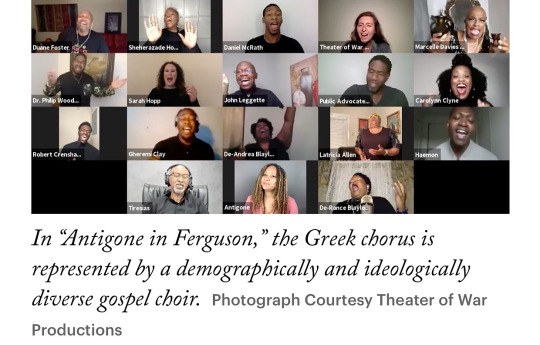
Excerpt:
If we borrow the terms of Greek drama, 2020 might be viewed as the year of anagnorisis: tragic recognition. On August 9th, the sixth anniversary of the shooting of Michael Brown, I watched the Theater of War Productions put on a Zoom production of “Antigone in Ferguson”: an adaptation of Sophocles’ “Oedipus” narrative sequel, with the chorus represented by a demographically and ideologically diverse gospel choir. Oscar Isaac was back, this time as Creon, Oedipus’ successor as king. He started out as a bullying inquisitor (“I will have your extremities removed one by one until you reveal the criminal’s name”), ordering Antigone (Tracie Thoms) to be buried alive, insulting everyone who criticized him, and accusing Tiresias of corruption. But then Tiresias, with the help of the chorus, persuaded Creon to reconsider. In a sustained gospel number, the Thebans, armed with picks and shovels, led by their king, rushed to free Antigone.
“Antigone” being a tragedy, they got there too late, resulting in multiple deaths, and in Isaac’s once again totally losing his shit. It was almost the same performance he gave in “Oedipus,” and yet, where Oedipus begins the play written into a corner, between walls that keep closing in, Creon seems to have just a little more room to maneuver. His misfortune—like that of Antigone and her brother—feels less irreversible. I first saw “Antigone in Ferguson” live, last year, and, in the discussion afterward, the subject of fate—inevitably—came up. I remember how Doerries gently led the audience to view “Antigone” as an illustration of how easily everything might happen differently, and how people’s minds can change. I remember the energy that spread through the room that night, in talk about prison reform and the urgency of collective change.
###
Again, the full article is accessible via the source link below:
#oscar isaac#theater of war#oedipus the king#antigone in ferguson#creon#frances mcdormand#john turturro#jeffrey wright#david strathairn#frankie faison#bryan doerries#sophocles#zoom#the oedipus project
117 notes
·
View notes
Photo
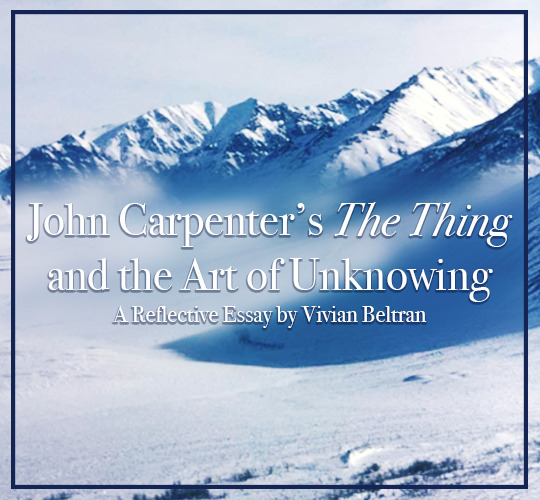
It should come as no surprise that John Carpenter and Dan O’Bannon were students in the same film class, that they created Dark Star together, and that they both had a great affinity for 1951’s The Thing From Another World. If you put Ridley Scott’s Alien, which O’Bannon wrote, next to Carpenter’s The Thing, the parallels cannot be contended. A group of people, bound together almost exclusively by their careers, are isolated and trapped in their own environment with a murderous monster. One by one, they are picked off by this alien beast and are forced to pull out all the stops just to survive. The tension in both movies is suffocating. The suspense stays well after the credits roll.
So, why did Alien excel and why did The Thing fail?
Alien was heralded as a science fiction-horror masterpiece, raking in over $200 million at the box office. The Thing, although now recognized as one of Carpenter’s best films to rival even the likes of Halloween, barely exceeded its $15 million budget by $4 million. What’s more is that critics panned The Thing almost unanimously after its 1982 release. And to what point?
When you compare the 2 movies, it objectively doesn’t make much sense. When you sit down and watch The Thing, without even thinking of its much more popular predecessor, it still doesn’t quite add up. There is not much I can say about The Thing that hasn’t already been said before. It’s well-known, now - the writing, the acting, the practical effects, the cinematography? Masterfully done. No arguments. So what went wrong?
The most popularly accepted explanation was that it just wasn’t the right year for it. In 1982, The Thing had to contend with the Summer of Spielberg, being critiqued alongside horror giant Poltergeist and science fiction treasure E.T. How could a stark and grim story of distrust and gore stand alongside such beloved classics?
But in tandem with these films and also calling back to the success of Alien, Carpenter cites reception from various focus groups: they hated the ending.
It should be assumed at this point that if you have not yet seen The Thing, you are sorely missing out. All the same, however, be wary of spoilers.
The end of The Thing is bitter, to put it lightly. Childs (Keith David) trudges through Antarctic snow, lit by the burning wreckage of Outpost 31, towards R.J. MacReady (Kurt Russel) who sits alone, already half buried. They observe their inevitable deaths, and drink to the supposed demise of their shapeshifting predator.
A lot is left out to die in the snow.
According to Carpenter, this ending was seen by test audiences as too dismal. And rightfully so, when you take into consideration the other popular releases of 1982. Carol Anne is ultimately saved, along with the rest of her family, at the end of Poltergeist. Elliot embraces E.T. before he finally returns home. And going further back, even Ripley is able to escape the xenomorph by the skin of her teeth and secure herself the title as one of the greatest “Final Girls” ever put to the silver screen.
And what of MacReady and Childs?
Well, that’s up to your imagination, Carpenter told a test audience member who asked who the final host was at the end of the movie.
“Oh, god. I hate that,” they responded.
As a writer, this loose ends style of concluding a story is almost expected from a lot of modern works. It’s written this way in order to haunt the reader, to linger and adhere itself to the real world in the most sardonic of ways. Think Joyce Carol Oates’s “Where Are You Going, Where Have You Been?” or Flannery O’Connor’s “A Good Man Is Hard to Find.” This almost anticlimactic close of the curtain arrived in the literary world long before it found its place in film, but it’s a big point of contention in mainstream criticism.
Dark or incomplete conclusions have been met with the most scathing of responses. Beware the black cutaway of Sopranos fame. Or the near-universal outcry against the third Mass Effect game that grew so much, the developers created a morsel of DLC content that maybe kind of confirmed a more optimistic fate for our dear Shepard.
But even for the horror genre, The Thing seemed unprecedented. The only fate darker to fall upon a mainstream protagonist was Ben’s untimely death in Night of the Living Dead. The tragedy of both movies is palpable - all this trouble to survive against inhuman killers, all this trouble to outlive something gruesome and maybe even make the world a better place, and what was left to show for it?
In short, Carpenter’s science fiction terror was too much of a bummer.
I personally did not take much of a liking to horror until much later in life. My parents didn’t filter the media I consumed as much as they probably should have, and I was scarred early on by movies as cheesy and entertaining as The Lost Boys and Blade. It wasn’t until late adolescence and into college that I set out to catch up.
My roommate at the time of this resolution had been a fan of horror her whole life, her favorites being Halloween, Candyman, and The Thing. Having already known a good deal about the former two, I decided to strap in for The Thing for the first time ever.
These days, I always have several soap boxes on retainer, just waiting for the next unwitting recipient of my usually-beer-induced rants. Brian Jones was killed, Jaws single handedly endangered sharks, banning books is a stupid practice, representation in media is important, etc. Predictably, one of these soap boxes is the general lack of appreciation of The Thing, both at the time of its release and today (it does not even make the top 100 on Rotten Tomatoes’s highest rated horror movies).
And yet, at the same time, if The Thing had achieved the credit it deserved upon release, I may not like it as much as I do today.
I make a point to not read too much about movies I am feverishly anticipating, and revel in the feeling of going into a well-known movie knowing as little as possible. Most of the time, it makes for the best viewing experience, but I’m sure I don’t even have to point this out.
This was my experience seeing The Thing for the first time. I was on winter break, staying at my parents’ house for the holidays. Everyone else had gone to bed, and I stayed up late in the living room, curled up under layers of blankets, content in perfect darkness save for the television.
I had no idea what to expect, as I had not been spoiled by any TV show making any blatant references and had not done any prior reading into the film itself. And I was absolutely delighted from beginning to end.
What stays with me the most is the special effects. It’s true what they say - that practical effects hold up better than CGI alone. And the production team didn’t cut any corners in this department. Stan Winston and his team, who were later responsible for the dinosaurs in Jurassic Park, helped construct one of the best animatronics in the movie. Rob Bottin, who brought this constantly-morphing creature to life from conception to every last slimy detail, went on to be hailed as a genius in his special effects career. And there is definitely something to be said for the work of cinematographer Dean Cundey whose masterful control of lighting and framing is best seen in Who Framed Roger Rabbit?
The extent of my knowledge of the titular creature was that it was an alien. That it was an alien who could consume multiple life forms and take on their shapes was both exciting and terrifying. There’s creative genius in this premise that thrills the science fiction lover in me, and also fascinates the bookworm in me. I had been a fan of Agatha Christie novels as a teenager, and to see a new and outrageous take on the And Then There Were None structure was incredibly novel to me.
The appeal wasn’t just that there was something out there, lying in wait to torturously pick off it’s victims one-by-one. It was that it could have been anyone.
At its core, horror as we know it has deep roots in whodunnit style murder mystery. With the rise of the giallo and the sensation of the slasher, horror movies of this nature are far from uncommon and can be seen as late as 1996 with the Scream franchise. Carpenter himself spurned a new kind of fear with his breakout success with Halloween by refusing to give a bodily face to its main antagonist. Here, with The Thing, he takes the eponymous killer character to the next level by giving it the genetically inherent function of deceiving its prey. Not knowing the true face of your murderer has proven to be inherently bone-chilling.
Even now, hundreds of horror movies under my belt later and still constantly learning, I keep coming back to The Thing. I really cannot think of another movie in my wide array of favorites that I love more than The Thing, and I truly believe it has everything to do with me not knowing anything about it upon my first viewing. Every other movie I can name on my (similar to the subject) constantly changing top 10 list of most beloved horror flicks was, at some point, spoiled for me in some capacity.
Think of how often the twins in The Shining are referenced in cartoons, of all the head spinning jokes made in reference to The Exorcist. Anthony Hopkins’s portrayal of Hannibal Lector in Silence of the Lambs has become so infamous, that I knew his dialogue (and Buffalo Bill’s) long before I ever saw the movie in full.
I don’t blame these references for ruining these movies. As a super fan, I understand that compulsion to pay tribute. It’s no one’s fault and to their credit that these films take lives of their own. But the repercussions don’t age well in terms of initial viewing experiences.
All that being said, I truly cherish how much I was not exposed to this movie. The unpredictability of the creature and the quiet, looming despair that comes with it create a horror unlike any other.
Although it was a box office flop, The Thing is now a welcome and praised name in both science fiction and horror. Even Quentin Tarantino made it known that The Hateful Eight was primarily inspired on several fronts by Carpenter’s underrated work. However, it has not pervaded pop culture like so many other horror classics have left their indelible mark on film vernacular. And to that end, I hope it remains in that slight shadow of anonymity for all future enthusiasts.
4 notes
·
View notes
Text
Voltron: Legendary Defender—an Unfulfilling Copy of Award-Winning Mecha Predecessor and Market Competitor, Transformers Prime?
Note, this comparison post has major spoilers for both Transformers Prime and Voltron: Legendary Defender. It contains screenshots/topics from the shows that some may find sensitive or disturbing.
The Transformers franchise and Voltron franchise have been direct market competitors, in toy sales and in (primarily boy-targeted) cartoons, since 1984. Both franchises have various iterations and reboots spanning decades. But in June 2011, Voltron: Force aired and stumbled. It was cancelled after a single season and achieved zero awards. In comparison, the competing Transformers franchise had aired Transformers Prime in November 2010, and the cartoon gained immediate critical acclaim, winning over older fans of highly successful previous Transformers cartoons—and pushing the content limits of the (US-rated) Y7-FV mecha genre.
By the time Transformers Prime (TFP) ended in 2013, it had earned several awards and set high standards for mecha cartoon shows in regards to animation, directing, plot complexities, and moral ambiguity, with a very extensive budget per episode.
This 2010-2013 show ultimately wasn’t your average kids show. Executive Producers Robert Orci and Alex Kurtzman admitted to using this show as their way to deepen the characters they fell in love with from writing the PG-13 live-action film, Revenge of the Fallen.
But did the show tone down its PG-13 origins? Not by much, if at all. TFP deals with very dark, edgy content, as well as sophisticated introspection into various characters. And it got away with it, in part, because it handled controversial topics so well.
Transformers Prime, under a TV-Y7-FV rating, boasts:
Multiple instances of major character death (even within episode 1, complete with blood splatters)
Graphic body horror and mutilation
Zombies
Physical and mental/emotional abuse
Electrocution, near-death experiences with major health consequences, betrayals, and torture
Amputation, disabilities, and characters actively experiencing PTSD and having mental breakdowns
Horror-genre monster chase scenes
Major trolley problems and moral ambiguity
War crimes
Good guys doing questionable/bad things, bad guys doing good things, and good guys working with mass murderers to defeat a common enemy
To an extent, transformers themselves do not exhibit a fully human image, which decreases the possible emotional reaction one might have to the graphic content. At the same time, this show dropped its money hard on developing the characters and making them as “human” as possible, and even having the human characters struggle with that realization, which resulted in a suspenseful, emotionally invested viewing.
The show still, to this day, enjoys an involved and productive fandom who delight in its characterizations, its plot, and its core message (which executive producer Jeff Kline explained as “the universal need to find or forge a family and a home”).
But why does Transformers Prime matter to today’s children mecha show environment? And why does it specifically matter to the audience who watched Voltron: Legendary Defender?
Executive Producers for VLD, JDS and LM, were still working on Legend of Korra, which ended in 2014, when they pitched a reboot for Voltron only months after TFP had finished in late 2013.
Hilariously, a lot of what happens in VLD had already happened in Transformers Prime, but with the twist of following through on a positive or morally meaningful message. So if you’re looking for a show that does what VLD did, but did it well—check out Transformers Prime. This show accomplishes:
Powerful female-gendered characters who live to enjoy their heroism and achieve their dreams
Individuals overcoming their PTSD and reintegrating socially
Humans not being the center of the universe and actually learning moral lessons
Multidimensional, dynamic villains, antagonists, and self-aware heroes
Abuse victims and villains breaking the cycle of evil
Deceased warriors being consistently remembered for their sacrifice and value
Socially and physically nonconforming individuals rising to great moral fame and recognition
A powerful character dying for the greater good, in which they transform into something even more powerful
Heroes being held to high moral standards
Still not sure about checking out TFP? Then enjoy this list of the vast extent to which VLD mimics TFP, as well as how TFP handles such topics with increased complexity and finesse compared to VLD:
Updates to Worldbuilding and Backstories
TFP, in keeping with live-action films, boasts aged-up human companions compared to previous transformer cartoons (Sari from TFA was only 9 at the start of the show). Transformers has, time and again, more typically aligned itself with bildungsroman (coming of age) storylines. Not surprisingly, VLD followed suit in adjusting its pilots to more strongly align to the teenager age group. For the Voltron franchise, however, this meant de-aging the pilots, which made them more fallible in a franchise where they were traditionally the center point of morality as adults. This is unlike the young humans in TFP, who are traditionally schooled by or in dialogue with the transformers about moral decisions and the hardships of growing up/becoming more responsible.
TFP’s synthetic energon or Synth-En, drives people crazy similar to VLD’s quintessence overexposure, bringing out the worst in them. Dark energon, which glows purple and is a mystical science-magic, is derived from a source of great chaos and lends disturbing powers, including reanimation of the dead and mind control, to one willing to bond with it. This is similar to quintessence manipulation as well.
The war between Decepticons and Autobots ultimately resulted in the destruction of their planet. Similarly, for the first time ever in Voltron history, both Daibazaal and Altea are destroyed in the war, leaving both people groups (or their remaining warriors) homeless and roaming the galaxy in guerilla warfare.
TFP boasts characters who live through incredible spans of time. VLD, for the first time in Voltron history, expands with a world of basically immortal aliens as well.
Updates to Characters
VLD also majorly expanded or revised previous Voltron lore, characters, and character arcs. In doing so, it brought Voltron characters closer than ever to their Transformer counterparts in TFP:
(A quick list of characters discussed, for reference if you need it)
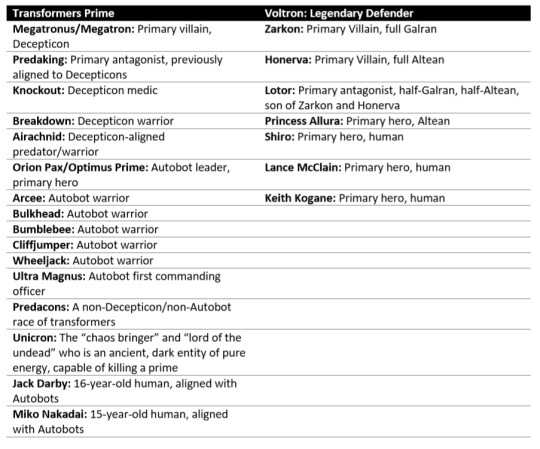
Honerva copies Megatron, both before and after his corruption. Honerva’s new history was entirely unprecedented within Voltron lore, but it was a core staple within TFP.
Both Honerva and Megatronus start off as good people, with very close friendships with the protagonist leaders, Alfor and Orion Pax. Both Megatronus and Honerva see societal ills, inequality, and want to fix them, challenging the traditions/hoarding of power by those of higher authority. Both Megatronus and Honerva are told their ideas for improving the world are wrong because they involve force and a demand for access to great power (For Honerva, it’s the quintessence field. For Megatronus, it’s the powerful Matrix of Leadership, which would result in making him a prime). Both characters ignore the concerns of Alfor/The High Council and grow increasingly more frustrated with the balance of power, desiring to usurp it for themselves. Both suffer the consequences and jumpstart a millennia-long war.
Their names change upon corruption. Megatronus becomes Megatron. Honerva becomes Haggar. Neither Megatronus nor Honerva are ever again able to truly separate from who they’ve become. The good part of them is permanently marred.
They’re both obsessed with a magic that can be used for great evil, from a questionable, destructive source (Dark Entity/rift creatures in VLD, the chaotic dark entity Unicron in TFP).
Both shows include an episode of the protagonists/heroes diving into the mind of Honerva/Megatron for more information, and having a harrowing experience in doing so.
Both Honerva and Megatron reanimate, to an extent, a dead soldier (Lotor/Cliffjumper) and use his body/weapons for their own purpose.
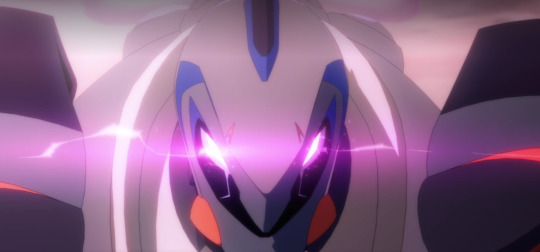

Honerva and Predacons Rising Megatron
In the final movie that ended TFP, Predacons Rising, Megatron’s character gets taken to a whole new level. Honerva’s arc eerily matches:
Both Honerva and Megatron are overwhelmed when the Dark Entities/Rift Creatures and Unicorn decide to destroy the world(s) most precious to them.
Both die and are reanimated back to life by dark power.
Upon reanimation, both can wield purple magic.
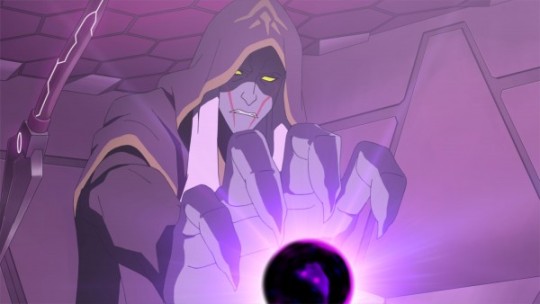
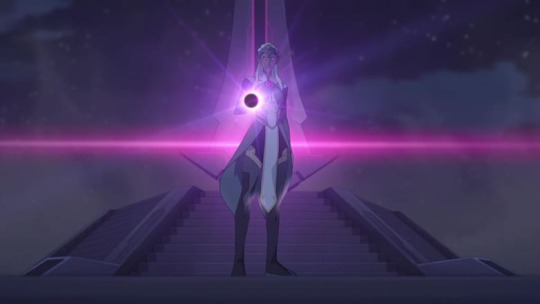
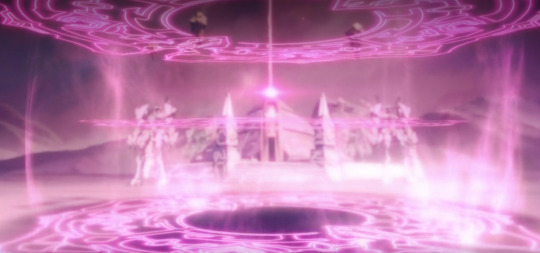
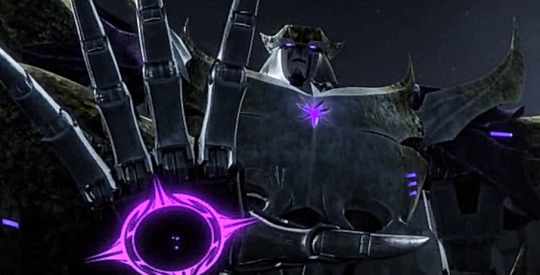
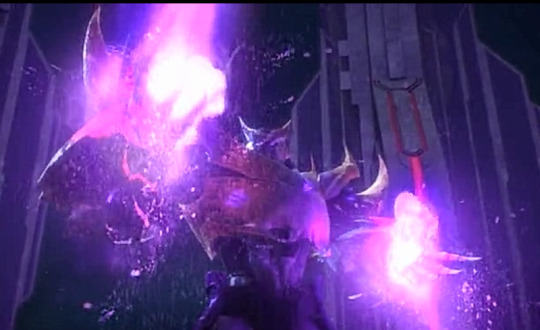
In TFP, Unicron, an ancient dark entity who is the source of all chaos and evil, says, “Your husk will simply be an instrument of my will.” Megatron undergoes a painful transformation that alters his usual form. In VLD, through contact with a dark entity and through the corruption from pure quintessence exposure, Honerva becomes Haggar. She is heavily altered visually, and is little more than a puppet of Zarkon’s will until she remembers who she is and fights back to regain herself, just as Megatronus does with Unicron.
They both gain the ability to peer into the minds and even alter the minds and behaviors of others.
Megatron cannot join the Allspark (go to the afterlife) because he’d been joined to the lifeblood of the chaotic Unicron, and he spends a deal of time cursed inside the mind of Unicron. Honerva’s soul does not move to the afterlife in death, but instead, being infused with quintessence, she is reanimated. They’re both the immortally undead. In addition, Honerva had “cursed” the souls of the OG paladins. They were inside her mind with her, unable to be in the afterlife because of it, similar to the plight Megatron finds himself in within Unicron’s mind.
They both give themselves over to scorched-earth policy. Honerva refuses the title to run an empire and goes on to nearly destroy the multiverse. Megatron, as Unicron’s puppet, admits to fellow Decepticons (who are subsequently disturbed by him), “I do not wish to conquer this world—I wish to eradicate it.” Honerva follows suit in her desire to achieve the past at any cost to the future of an entire multiverse, carrying Megatron’s banner that, “The past shall consume the future!”
A quasi-redemption arc: Both Megatron and Honerva achieve what they want. Megatron gets bonded to the spark of a great, chaotic power, able to warp time and space as a new, all-powerful being. His abilities allow him to quickly fly to a regenerated version of his home world, Cybertron, which had been destroyed millennia ago. Honerva gets access to Oriande, transreality materials, and achieves entry to a dimension with a still-living family on her home world of Altea (which was living, unlike the Altea she know, which had been destroyed millennia ago).
Once they’re given over to the power or end they desired, they do not achieve the true effect they wanted. They have a moment where they lose their own personal agency within that situation, only to rage to destroy everything at great risk to themselves, and then from out of the rage, fall into a daze of distaste for what their desires have brought them.
Then they both act defeated, whiny, and salty over how nothing’s like what they wanted.
They both disappear off into the sunset in a disquieted, defeated sense of, “Whatever, I guess I’ll be good now and do my own thing because I’m tired.” (Paraphrasing here.)
In TFP, the insanity of Predacons Rising Megatron is described by Predaking (another character) as, “Dark magic…perpetrated by the demon who lives in Megatron’s skin.” In a similar manner, Lotor accuses the Oriande-infused Honerva of being “an abomination.”
Zarkon is a mirror to the standard, more well-known Megatron. But in VLD, he boasts similar characteristics, like Honerva, to Megatronus, picking up Megatronus’s gladiator history. Class issues are important to both Zarkon and Megatronus as well.
It’s implied that Megatron was born into a very low class and rose to power through the gladiatorial ring by rite of combat, bolstering his political career. As a gladiator “in the pits of Kaon,” his rise to become the leader of the Decepticons mirrors Voltron’s brand-new lore of Zarkon rising to imperial power through the Kral Zera, which is a ceremonial gladiatorial arena to establish the new leader through rite of combat.
Zarkon functioned as a military mentor for Alfor; Megatronus was a political mentor to Orion Pax.
According to the lore of the original Thirteen Primes, Megatronus Prime got into a fight with his brethren that resulted in the death of his lover, Solus Prime, a weapons forger. Megatronus Prime’s title as “The Fallen” being closely related to in-fighting specifically over a lover in many ways echoes in the ultimate breakdown of friendship between Alfor and Zarkon, specifically over Honerva and her abilities to manipulate quintessence into tactical advantages/weapons. The end result is that Zarkon “falls” as well through Honerva’s death, just as Megatronus Prime falls through the death of Solus Prime.
Zarkon is massively injured and in a state of unconscious for a time, disrupting the empire. Megatron as well is massively injured in a state of unconsciousness for a time, disrupting the order of command for the Decepticons. In both instances, this is a major plot device to introduce other characters to the show and deepen political conflict.
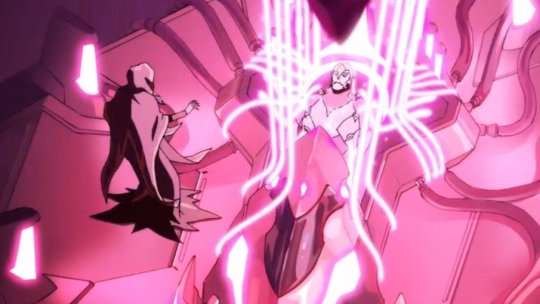
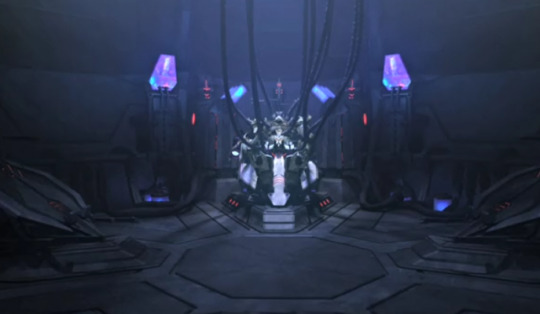
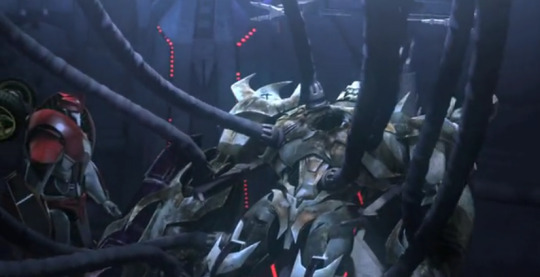
Zarkon’s armor and facial reconstruction for the reboot more closely mimic Megatron’s elongated face and eye-set, as well as his very wide-shoulder, spiky armor, complete with angled armor lining his cheeks. It’s similar enough that others have poked fun at their similarities.
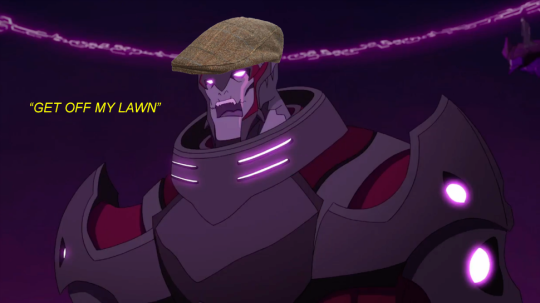
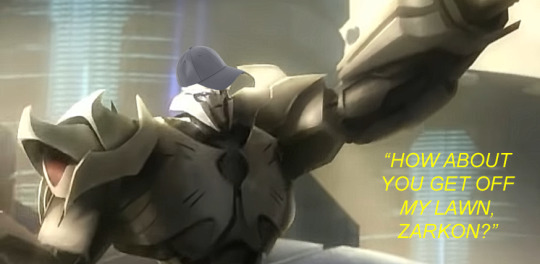
Alfor’s history more closely mimics that of Orion Pax. They’re both initially great friends with the very person who would later seek to kill them and their friends.
It’s implied that Megatronus suffered through the very issues that he was critiquing to the High Council. Meanwhile, Orion Pax was of a higher class and coddled from experiencing the same societal ills. In many ways, this echoes how Alfor critiqued the behaviors of Zarkon and Honerva, while standing from a place of incredible power through Oriande, as well as physical peace and comfort.
Alfor and Orion Pax are both very scholarly individuals without the military expertise as touted by their counterparts, Zarkon and Megatronus.
Alfor and Orion Pax are both initially deceived by the heartfelt words of their friends, only to realize in horror what their friends actually desired beneath it.
Orion Pax and Alfor stand as the ultimate inheritors of the powers and status coveted by Zarkon/Honerva and Megatronus.
When Orion Pax is converted to Optimus Prime, his old self somewhat dies, and he becomes a more perfected, all-powerful version. Alfor, likewise, dies in the war…and his legacy is inherited by Allura, who is canonically shown as even more powerful. She carries on the mantle/legacy as previously set before her by her predecessors.
And last but not least of the Big Four, Princess Allura’s arc in VLD very closely mimics Optimus Prime’s arc in TFP.
Like Optimus Prime, Allura becomes locked into a millennia-old war that she did not start herself.
Optimus Prime is the last of the primes. Princess Allura is the last of the royal Altean line. Both primes and royal Alteans have access to deep knowledge and mystical abilities coveted greatly by others of their race.
The High Council bestows the Matrix of Leadership, which is the core of Optimus Prime’s power. The Ancient Alteans of Oriande impart their wisdom and knowledge to enhance Allura’s power. Megatronus’s failure to achieve the Matrix, receiving only rejection in return, is echoed in Lotor’s rejection and fall in Oriande, who like his father sought to obtain such power through Galra-standard force.
Optimus Prime is a member of an endangered species, believing his few Autobot comrades to be some of the only ones remaining after the great war. In a similar way, Princess Allura struggles with the isolation and fall of Alteans. Both Optimus and Allura are separated by vast distances of space from other possible survivors of their own kind.
They both agree to truces with great enemies and unknown powers for a specific end. Allura accepts the dark entity and works alongside Lotor. Optimus makes several deals with Megatron, at great hesitance from his team.
Both wield great power that no one else currently can.
They both sacrifice their lives and own energy in the end to restore life itself to worlds, because they cannot separate themselves from the power it takes to restore life.
They both pass down a “transformation” to one of their brethren before dying. Princess Allura gives Altean marks to Lance. Optimus converts Bumblebee to a warrior.
Their comrades all stand and watch as they willingly sacrifice themselves, and they have first-row seats to a major visual outpouring of light and life.
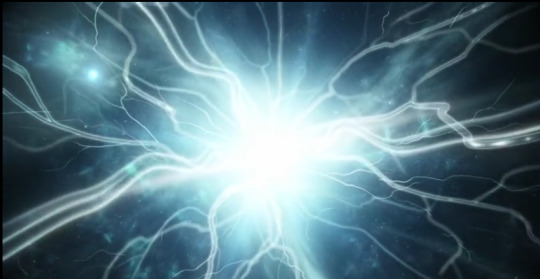
(Screenshot explanation: The visual effect of Princess Allura sacrificing herself to restore life to the multiverse.)
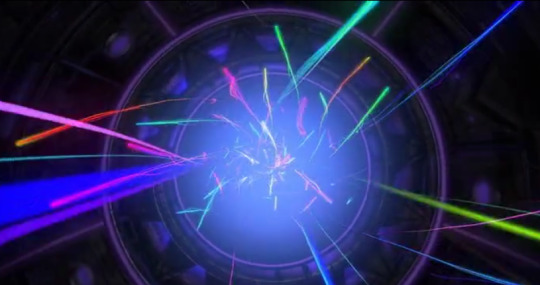
(Screenshot explanation: The visual effect of Optimus Prime sacrificing himself to restore life to the Well of All Sparks.)
Aside from The Big Four, there are other TFP characters with extreme similarities to VLD supporting characters.
Knockout/Breakdown/Predaking as Lotor
The Knockout connection to Lotor
According to Hasbro’s vice president of development and scripted entertainment, Mike Vogel, Knockout as a character received several upgrades because his previous iteration as “Lugnut” wasn’t considered sexy enough. Similarly, Lotor in VLD was upgraded to be a prettier bad boy in several ways that he hadn’t been before, especially in regard to physical clothing and behavior. Both pretty bad boys ultimately boasted a tight waist, spiky shoulders, great eyeliner, and heavily angled paneling on their torsos:
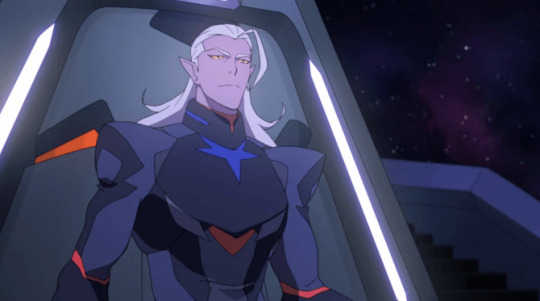
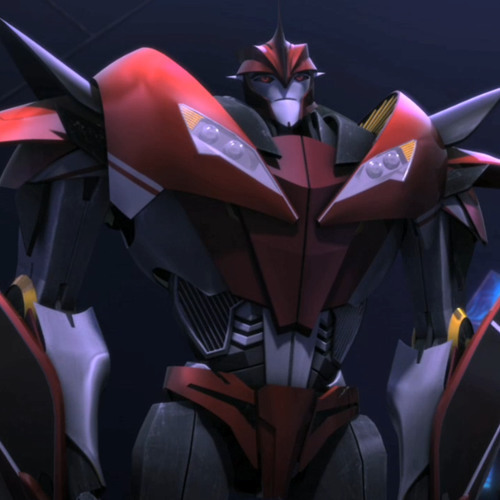
Knockout is coded as being “different” than most of the other Decepticons and is looked down upon for having a road-based alt-mode instead of an alt-mode that affords flight. In being so, he is more similar to the Autobots despite being born as a Decepticon. Likewise, VLD heavily increases the amount of attention and derision given to Lotor for being half-Galran and half-Altean. Both Knockout and Lotor profess great confidence and satisfaction in what they are, though, regardless of anyone else’s critique.
Knockout is summoned to Earth after the fall of Megatron, who remains in an ill, unconscious state. This is reflected in how Lotor is introduced into the revised Voltron series, to assist his reigning father in a time of need.
Knockout is a medic and is tasked with preserving life—or taking it out. Lotor’s base motivation is also to preserve life, but he maintains Knockout’s underhanded side of also deciding when to eliminate a loose or unproductive end.
Unlike previous iterations of Lotor, the VLD Lotor is excessively more evasive and less likely to barge in bull-headedly into battle. Knockout uses similar tactics.
Knockout gets melded into a ship (although unlike Lotor, he does get out and isn’t dead).

Knockout constantly schemes for more power and prestige, using underhanded tactics. He has very little loyalty but does have a deep bond with fellow Decepticon Breakdown, who functions as the muscle to Knockout’s intelligence. They’re usually seen together as two halves of the same brotherly unit. In a similar way, Lotor is the scheming commander and point of intelligence in his own small group. His generals are overall the brawn, like Breakdown.
Knockout provides confidential information about his old Decepticon comrades to help the Autobots while in custody as a prisoner of war. (Although unlike Lotor, Knockout demands, “We’re prisoners of war; we have rights!”)
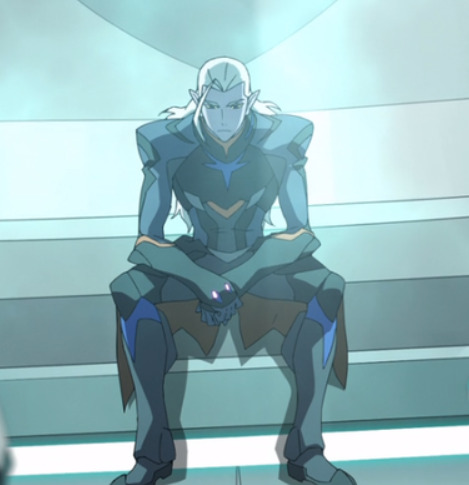
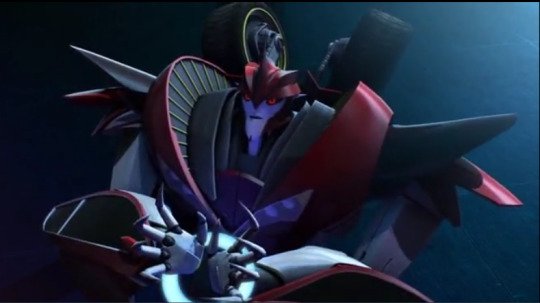
The Predaking connection to Lotor
Predaking is a type of Predacon, an ancient beast that died long ago but is brought back to life through experimentation. In ways, his ancient status and the strange circumstances of his “birth” echo in the way Prince Lotor is a vestige himself from ancient times and was still growing in Honerva when she died, suggesting that he died as well or was somehow preserved by his infusion with quintessence. The result is that his life is unnaturally sustained by quintessence itself, when he would have otherwise been dead. Similarly, Predaking’s existence was not possible without intentionally overriding natural limitations, since his kind could not be “sparked” naturally.
Predaking is groomed to be a weapon for Megatron and initially assumed to be a dumb beast. In doing so, he endures ongoing physical and mental abuse by the Decepticons, particularly Megatron’s second in command, Starscream. As he grows more intelligent and powerful, he increasingly balks against the treatment he receives and loses loyalty to Megatron. This is similar to Lotor being groomed as the heir to the Galran throne via brainwashing but yet suffers abuse for what he is. He, like Predaking, ultimately grows to reject much of what he’s been told to believe about himself and his place in the world. Both Lotor and Predaking are strong enough to challenge and nearly defeat the main heroes of the shows, Voltron and Optimus Prime, respectively.
Predaking, in hatred for Megatron who tried to make him a weapon, attacks him with the intent to kill. Lotor, likewise, attacks his father, Zarkon—although Lotor does achieve killing him.
Both Predaking and Lotor are core to the dismantling of various alliances upon the discovery of a colony of innocents being killed in the name of tactical war advantages. In both cases, the innocents were people in tubes being groomed/harvested for war purposes.
The Breakdown connection to Lotor
Decepticon Breakdown is betrayed by one of his own team members, whom he had found attractive and had flirted with. The Decepticon femme Airachnid kills him. The distorted remains of his body end up being used for spare parts for a terrorist’s horrifying fusion of organic flesh and mech technology. Ultimately, Breakdown’s body is a victim of being used post-mortem to further the military aims of another person who wanted to exploit him. Breakdown’s personal agency is completely removed, and his body receives no rest.
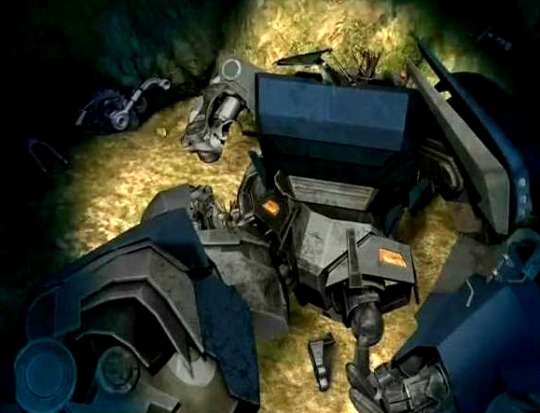
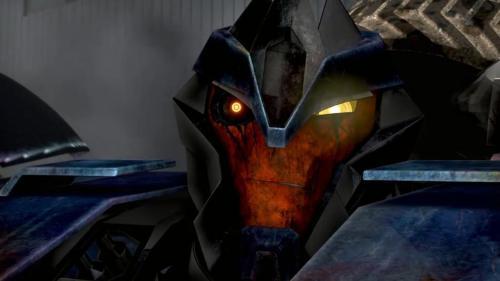
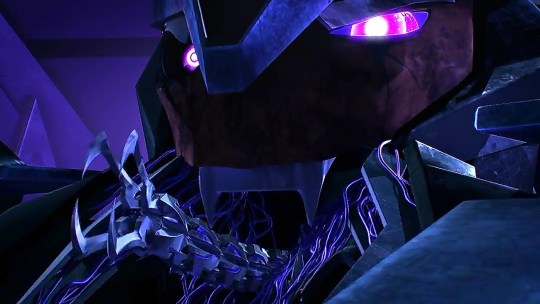
Lotor, likewise, is betrayed by Voltron and specifically by Princess Allura during an alliance. Princess Allura, as his love interest, kills him. The distorted remains of his body, which are fused to the Sincline ship, end up being used post-mortem to further the military aims of Honerva. Lotor’s personal agency is completely removed, and his body receives no rest.
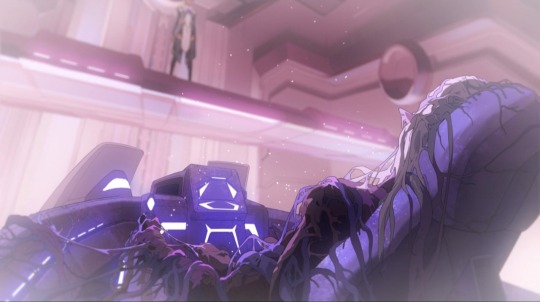
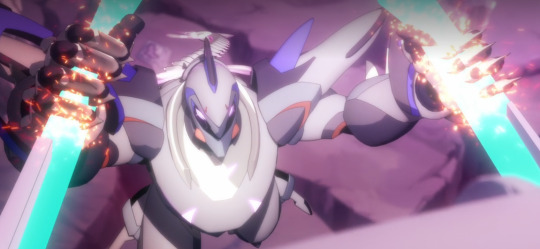

Bumblebee as Lance
Bumblebee and Lance, as the beloved young but inexperienced warriors, are both killed and brought back to life.
Bumblebee has progressively taken over as the frontrunner of the show within the Transformers franchise. Likewise, Lance gained more screen time and heightened significance in VLD compared to previous Voltron iterations.
Lance in the VLD finale and Bumblebee in the TFP sequel both struggle with the dissonance between who they were during war and now who they are as guardians or people look up to, but who are somewhat vestiges of the past.
Optimus Prime, prior to his death, changes Bumblebee from a scout to a warrior, which was not what Bumblebee was originally designed to be. Princess Allura, prior to her death, alters Lance from being purely human to exhibiting Altean characteristics.
Arcee as Shiro
They both suffer from PTSD, having been tortured by the enemy, interrogated, and experimented on. Arcee, being mechanical, has had her visible scars repaired, but the nightmares remain. Shiro similarly experiences PTSD.
They both have lost a significant other to war. They’re both afraid of losing the children they’re responsible for.
They both find family and are able to find happiness by the end, putting to rest any conflict they had over their previous partner.
Nemesis Prime (a Clone of Optimus Prime) as Kuron (a Clone of Shiro)
Nemesis Prime is a “clone” of Optimus Prime, developed by the human terrorist group M.E.C.H. He exhibits a physical appearance similar to Optimus Prime but, when activated, carries out their will of death and destruction.
Similarly, Kuron is a clone of Shiro developed by Haggar. He exhibits a physical appearance similar to the true Shiro, but when activated, carries out Haggar’s will of death and destruction.
The reputation of Optimus and Shiro are temporarily called in question before others realize what’s actually happening.
Jack Darby as Keith Kogane
Both have missing/dead fathers. Their mothers are alive, and they’re very close to their mothers, but said mother is often not a part of their daily life, given her own missions.
Both are loners and go through an arc of no longer wanting to be a part of the team, during which the team has to remind them of what they’ve gained and how important they are.
Both have a high sensibility to wanting to do the right thing, but not feeling worthy or wanting to have a position of power.
Both are constantly annoyed by the bull-headed antics of their teammate (Miko/Lance), often rolling eyes or getting on their case, but end up bonding with them in the end.
Both are the “human” lead for their team.
Both inherit great power. Optimus Prime, when no longer able to complete the mission, hands Jack the Omega Lock key. When Shiro is no longer able to be Black Paladin, Voltron chooses Keith to carry it forward.
And there’s so many other character similarities.
Moral Ambiguities
VLD also copies the moral ambiguity standards set within Transformers Prime.
In an Afterbuzz interview at the 12:52 mark, JDS and LM uplifted VLD as fairly groundbreaking for children’s shows, per its moral ambiguities. JDS said, “The finale is almost, I don’t know—I don’t wanna say unlike anything that you would see in other like-minded shows, like let’s say, like, Transformers or Power Rangers, or….something that Voltron was like, by outward appearances, being compared to. But it was something I think really exciting for us to explore because we did create villains and create heroes that worked within this very kind of, like, shades of gray spectrum. There was black, there was white. But we played in this weird morally ambiguous zone a lot of the time. And that was—I think, it was important for audiences of every age group to see that.”
Lauren Montgomery agreed at 13:33, stating, “We also came from working on shows like Avatar the last Airbender, and Korra, which very much pushed those boundaries as well, and were extremely ground-breaking for children’s programming. And it was not something that was coming out of western animation.”
Afterbuzz Interview: https://www.youtube.com/watch?v=MudCcj6QRzA
However, the vast majority of what VLD did plot-wise with moral ambiguity was already used inside TFP, a western animation cartoon airing well before Korra:
The Colony Problem
In TFP, Autobots Wheeljack and Ultra Magnus knowingly and willingly commit massacre against innocent beings. Predacons (a different race of transformers, based on ancient beasts) were being groomed in test tubes in Megatron’s facility for the purpose of becoming Decepticon warriors. In fear that Predacons would hurt humans, the Autobots choose to kill them all. This decision comes back to haunt them dearly, through Predaking’s discovery of the massacre.
Predaking, who is a Predacon himself, is an antagonist of incredible moral ambiguity. He expresses great frustration with both the Autobots and the Decepticons. He despises the abuse he endures from the Decepticons, despises Megatron for betraying his kind to the Autobots, and then despises the Autobots, who knowingly commit massacre against his own kind. His tactics and perspectives, as he refuses both sides of the war and fights to create his own space, result in him becoming an ultimate antagonist to both Autobots and Decepticons.
The Trolley problem as experienced by the Autobots (sacrificing some to save many), and the resulting political fallouts, are mirrored within VLD.
In VLD, Prince Lotor had faced a similar trolley problem as well, in which he was instrumental in how several innocent Alteans were sacrificed for an unknown military aim against the Galra. The slain Predacons and second-colony Alteans are both shown in tubes in an experimental lab, represented as victims/cannon fodder of a much larger military function.
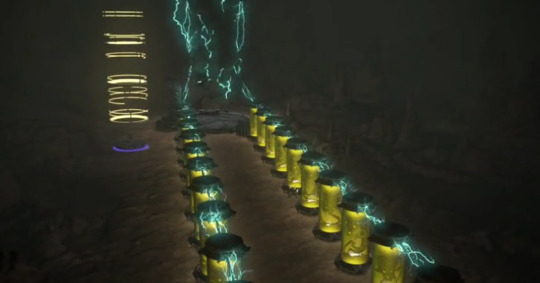
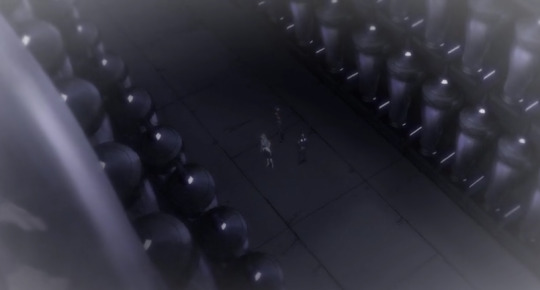
In VLD, the discovery of the Altean colony results in an utter destruction of previous alliances. Similarly, Predaking breaks ties with everyone in total disillusionment and rage, never again believing Autobots when they say they believe in peaceful coexistence of two races. His sentiments are echoed into VLD, in which the Galra are suspicious of Voltron and call them traitors.
Moral Shades of Gray: Characters Who Fall on a Spectrum
TFP’s Predaking has his own code of honor and is a primary example of a morally ambiguous character. He absolutely despises the Unicron-reborn version of Megatron. He snarls, “Dark magic…perpetrated by the demon who lives in Megatron’s skin.” This implies that Predaking ranks himself higher in his ways than Megatron. But Predaking, in his desire for revenge and power, also falls short of the stated moral standards of the Autobots. Similarly, Lotor absolutely despises the witch Haggar/Honerva, calling her an “abomination,” and yet he fails to meet the moral standards of Voltron and is therefore named an enemy despite their alliance.
Moral Focal Points: Have the Good Guys Always Been Good? And Have the Bad Guys Always Been Bad?
In TFP, the Autobots are said to have been the moral standard. However, they also bear a dark history of class issues / inequality and political corruption.
Similarly, in VLD, Alteans posit themselves as the moral and diplomatic standard, desiring peace for all. However, the Ancient Alteans hoarded Oriande’s power for only a select few of their kind. Alfor had no problems barreling in and using force against other people groups, in s3 flashbacks. He also created the most powerful weapon in the universe to enforce his version of peace, in which Voltron itself feeds off the life force of its paladins. Alteans additionally were able to terraform entire planets, the technology of which would have required immense power (where did they harvest that from?), and the result was the massacre of all life on said planet, for them to use to their will. These canon details suggest the Galra’s “komar” life-harvesting technology may have originated from Alteans themselves.
In VLD, the Galra (through Commander Lahn) express frustrations with Princess Allura’s coddled mindset, which mimics Megatron’s own frustrations with Autobot morality, which is derived from a position of power and comfort.
So, in general, there’s a moral similarity between TFP and VLD, in which the “heroes” have these dark pasts and yet attempt to smooth it over, while the “villains” are victims of a much larger, oppressive order and are calling the heroes out for their hypocrisies and crimes, demanding access to the same power as they wield, or committing similar crimes as the heroes and suffering harder for it.
So given all these similarities, how in the world is TFP so much better than VLD, message-wise?
1. TFP actually understood moral ambiguity.
In TFP, Megatron disbands the Decepticons, tired of bloodshed, without turning to the Autobots or acknowledging their perspective as the morally correct one.
The humans in TFP are excessively fallible, just like their transformer counterparts. There is a human terrorist group, M.E.C.H, who paces both Autobots and Decepticons, desiring their technology to enforce their will upon the world. These humans commit great horrors against both sides of the war, resulting in difficult decisions, odd truces between the Autobots and Decepticons, and humans fighting other humans. In other words, humans are NOT the moral center of the universe.
Some Autobots have looser morals and less self-control than others, which grates against the sensibilities of the more morally sensitive and results in a lot of disagreement and problems.
TFP consistently reflects on lessons learned. The heroes admit when they are wrong or fail to achieve moral perfection in their actions. They have to struggle through those decisions, the consequences of those decisions, and are bolstered to do better, be better.
The villains are not simply obsessed with power and are also capable of having empathy and doing things outside of pointless destruction. Breakdown is pleasantly surprised when one of the humans asks, “How are you?” And Breakdown responds politely. He also expresses sympathy for the hard work and struggle of the vehicons, who are servant-class workers on the Decepticon ship, similar to Galran robots. Likewise, Knockout expresses a love of human zombie movies and going to drive-ins to watch them, along with appreciating human vehicle design and street racing.
TFP shows villains scared and in pain, with a tremendous range of emotion and dreams. This is way more complex than how the villainous Galra are shown in VLD, who are consistently on a war path.
The heroes are willing to side with the villains (who killed their own people) to defeat common foes. The tension and resulting conversations from those truces are hilariously more complex than VLD, in which Voltron refused to work with Emperor Lotor, who is implicated in killing Alteans in the larger war against Galra. Instead of pursuing the tactical advantage of an ongoing alliance, Voltron simply assassinates him without due process for his war crime, asserting Voltron as the only morally unfallible point in the universe.
TFP shows the human heroes learning when they’re fallible and trying to be better.
TFP actively struggles with how human children/teenagers are endangered by the war, even when the children themselves don’t understand the danger.
2. TFP does a lot of other things well.
TFP always maintains a perspective that the true battle between good and evil is not a physical one—but one fought within the heart. Per Optimus Prime, “As even Megatron has demonstrated on this day, every sentient being possesses the capacity for change.” This is vastly unlike VLD, which stumbles to handle the perspectives of Voltron antagonists or the belief that people can truly change.
Megatron endures the very suffering he’d inflicted on others and comes to the decision on his own to stop his violence and disband the Decepticons, also ending his own “stereotypical toxic masculinity” arc. This contrasts heavily with Honerva, who goes into the afterlife without an understanding of why she can’t be happy as she is, demanding happiness and a family after she’s caused so much pain even to that family, perpetuating her own “stereotypical toxic femininity” arc.
There is a significant difference in the sacrifice of Optimus Prime compared to the death of Princess Allura. Optimus Prime’s sacrifice was a major power move, as well as not unexpected, given Transformers’ history of killing him off. (Although back in his first death in 1986, this was a horrifying shock to children who looked up to Optimus as a father). But within the context of TFP, Optimus had undergone a low point in the story prior, only to be rebuilt stronger than ever and growing in power and confidence as the re-energized leader of the Autobots. He had everything to live for (family, friends, regenerated planet, power) when he chose to sacrifice himself for others. Additionally, he knew there was hope in choosing to sacrifice his material body to restart the Well of Sparks, so that life could be regenerated on his planet. Optimus Prime even contextualizes his death in terms of rebirth and hope. His last words to his friends are: “Above all, do not lament my absence, for in my spark, I know that this is not the end. But merely, a new beginning. Simply put…another transformation.” He flies into death, more powerful and revered than he had ever been. He has a peaceful expression on his face. All of these details are wildly different from VLD. Princess Allura, like Optimus Prime, hits a low point beginning in s6 when Voltron’s alliance with Emperor Lotor unravels. But unlike Optimus Prime, Princess Allura continues to be progressively stripped of identity, power, and personal agency, careening into utter despondency until she willingly kills herself, with nothing to live for. She constantly gives up her own personal power to others, increasingly isolates herself from others, grows more emotionally volatile, denies her own people, and sinks into the background as other characters determine her life and decisions. There is nothing personally identifying about her by the end, with even her crown and state of dress removed/replaced with the uniform of a basic human soldier. Sorrow for her value and death comes too late in the story, when she has already become the most expendable character. It’s of additional significance that no one in VLD tries to help Princess Allura by offering other ways to resurrect the multiverse. There are only some paltry sniffles and weak, “No, don’t” responses. This is a huge contrast to TFP, in which several characters immediately are incensed by the thought of losing Optimus Prime. They jump in with ideas for how to possibly save their beloved leader, willing to endure more personal hardship on his behalf. They express that they didn’t fight this hard to resurrect Cybertron, only to lose someone they cared about. Optimus Prime explains why their ideas would not work, but in doing so, reveals that he is already one with the All Spark (meaning, that his spark is already part of a mystical collection of souls with the capacity to be born/reborn, and that continuing to live, bonded to the All Spark, would be denying all other souls from experiencing life). It is his explanation that bolsters the necessity of his sacrifice and converts his final words from being a hollow comfort to a genuine conviction that this was not the end. That they would all someday meet again.
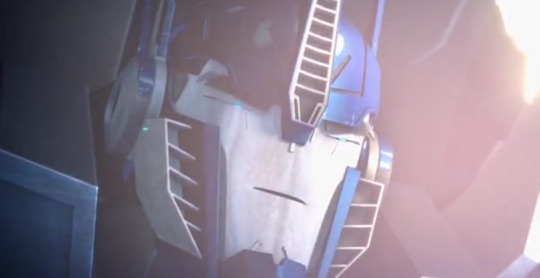
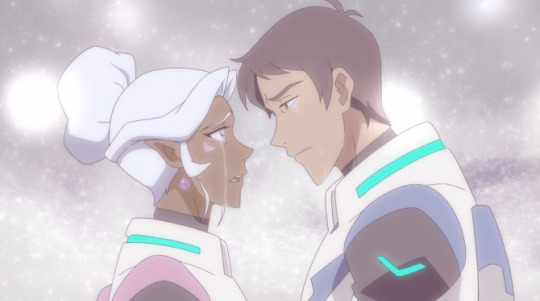
In the TFP sequel, Robots in Disguise (2015), it’s revealed that Optimus Prime, in death, has become an interdimensional being, capable of still interacting with and providing guidance to Bumblebee on the “human plane,” all while being spiritually tested by greater beings with even more interdimensional power than him (the Primes). Interestingly enough, this topic is mirrored within VLD. Such interdimensional beings are confirmed to exist via season 7, in which the Voltron paladins are whisked away by an all-powerful interdimensional entity, who tests their worthiness as warriors. Additionally, some of the VLD meta by @leakinghate posits that an afterlife existence for Princess Allura and Lotor as interdimensional beings was supposed to happen in the VLD finale, but was ultimately not published. Had such been published, Princess Allura’s final arc would have further matched Optimus Prime and better maintained the hope and meaning associated with his arc.

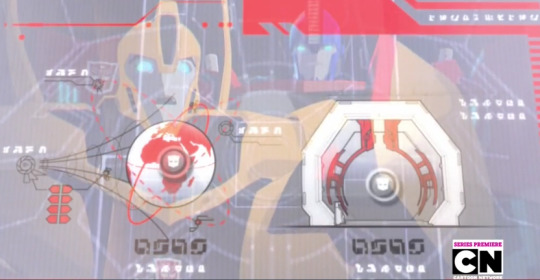
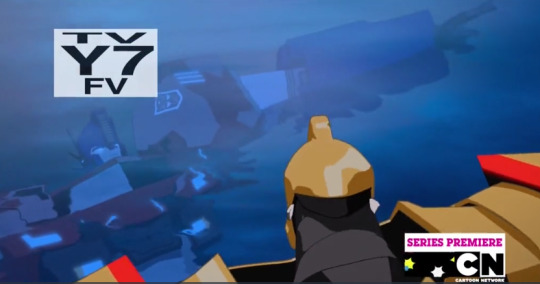
Transformers don’t always save the day. Sometimes, it’s a little human girl with a baseball bat, or a little human boy with coding skills, or a teenager willing to put themselves in harm’s way to protect them. This greatly humbles the Autobots, some of whom struggle with their pride and the reality that they don’t have all the answers all the time, and that sometimes, they need to be protected too.
TFP actively struggles with both positive and negative prejudices assigned to humans and transformers. The humans originally think the transformers are just robots without souls—they think it’s all a game. They soon discover that transformers can bleed, and have emotions, and have a soul than can die. Likewise, some transformers find the humans to be a nuisance and despise their “fleshiness,” but soon overcome those perspectives to grow very protective and attached to humans. In other words, everyone struggles through their own perspective and learns on the way.
Optimus Prime remains the consistent point of morality for TFP. When he does controversial things, like engaging in an alliance with Megatron or allowing medical aid to be provided to Decepticons, he acknowledges those things and explains his reasoning. This is unlike Voltron, who engages in action without reflection while still demanding a position as the unquestionable moral center of the universe.
Knockout, as the Lotor bad boy of the series, defects and actively becomes a member of the Autobots. He admits he didn’t have the best role models, and it’s shown throughout the show that he endures physical and mental abuse by some Decepticons as well. He makes a cameo in Robots in Disguise (2015), suggesting he is still alive and well as an Autobot. Optimus Prime at the end of TFP includes Knockout when he says each of his teammates had acted as a prime, offering a tremendous weight of value and respect to Knockout.
Even Predaking, the antagonist, ends up helping the Autobots when it counts and otherwise remains distant with them.
Predaking gets justice against his abusers.
Autobots and many Decepticons are consistently horrified and disturbed by the crimes perpetuated against Decepticon Breakdown, whose body is taken and mutilated by terrorist group M.E.C.H.
Arcee manages to positively cope with her PTSD and remains as an active, plot-intrinsic character to the end, with several episodes dedicated to her own character arcs and the advantages she provides the overall team. She lives to see and experience her dream of a restored planet come true, without being turned into an example of the sexy lamp trope.
The transformers are able to achieve their goal of restoring Cybertron and generating new life, which allows several other characters to begin healing from the trauma of war and regain what they had lost.
The humans who make villainous decisions have dire consequences.
The human Miko rises up to become an Autobot Wrecker in her own right, without sacrificing or compromising anything about who she is, how she presents herself, or what her other interests are.
Bulkhead originally despises Decepticons but ends up rescuing his own sworn enemy from torture and dismantlement because he learns to put justice for and the safety of all people first.
The number of parallels between Transformers Prime and Voltron: Legendary Defender extend even beyond this list. And yet as seen above, TFP succeeded in so many of the major areas where VLD ultimately failed.
Transformers Prime, even years after its finale, remains as the award-winning show that transformed dark and edgy content into messages of hope, redemption, gender equality and social acceptance, moral responsibility, the power of teamwork—and did it as a Y7-FV show geared primarily for young boys.
So, if you were disappointed in VLD and how it ended, check out the edgy but satisfying TFP for what a real children’s mecha show should be like.
(Special thanks to @mermaider00 for being my TFP buddy and for suggesting some of the points discussed in this post!)
#Voltron#vld#Voltron Legendary Defender#Transformers#Transformers Prime#tfp#s8 critical#meta#AN ADVERTISEMENT FOR TRANSFORMERS PRIME#Y'all need to watch this show#TFP was the VLD I had wanted all along and already had#I watched tfp when it first ran#then I had deja vu when I went back to rewatch after watching VLD#it's not a perfect show#still has flaws#the show even garnered a convention panel in 2015 about various production and show bible and budget issues#but it stands the test of time#i love transformers prime so much
51 notes
·
View notes
Photo


Spindle Fire by Lexa Hillyer
Warning: Contains spoilers
Welcome back to Fairy Tale Friday! Today we’re looking at the first “Sleeping Beauty” retelling of this feature. So let’s jump right in!
As a Retelling:
Hillyer draws from the more well-known Grimm version of the tale called “Little Briar-Rose,” which ends with the prince waking Sleeping Beauty. Earlier versions of the tale, such as Giambattista Basile’s “Sun, Moon, and Talia” and Charles Perrault’s “Sleeping Beauty in the Woods,” include a frankly more interesting second half involving the prince’s first wife or mother attempting to murder and eat Talia/Sleeping Beauty and her children. Hillyer chooses not to utilize this plot point and focuses her novel on the familiar and famous part of the story. However, Hillyer does include many embellishments and deviations right from the start. Instead of focusing on a single princess, we have two sisters as our protagonists: Aurora, who is our Sleeping Beauty, and her half-sister Isabelle, called Isbe. We also see the sibling relationship between the main antagonist, Malfleur, and her sister, Belcoeur. While there are multiple romantic relationships, the relationships between these sets of sisters are the source of the major plot points.
This book has the most unique take on the faerie gifts I’ve seen in a “Sleeping Beauty” retelling. In both the Grimms’ and Perrault’s versions, the princess is given gifts by faeries or wise women at her christening. These gifts include beauty, grace, wit, virtue, and musical abilities. In Perrault’s there are seven faeries and in the Grimms’ there are twelve, but Hillyer uses three (as does Disney’s Sleeping Beauty). Whereas the gifts in the fairy tale are given freely, the ones in the book come at a price. The faerie offers the exchange and Princess Aurora’s parents accept or deny it. They thus barter away her voice for beauty and a good temper and her sense of touch for grace. The third faerie’s amendment to Malfleur’s curse comes at a price as well; she requests Aurora’s sight. The queen balks at this and through some tricky wording presents Isbe in Aurora’s place for this tithe. Isbe grows up blind while Aurora grows up mute and unable to feel anything. While Isbe never regains her sight in the book, Aurora is able to speak and feel once she is in Sommeil.
Both Perrault’s and the Grimms’ tales involve a fairy setting the curse on the princess. The curse states that the girl will prick herself on a spindle and die, and this is the same curse Malfleur casts on Aurora. Hillyer creates a backstory for the reason behind the spindle. Malfleur supposedly saved everyone from her sister, Belcoeur, and she feels they have been ungrateful to her and wants the curse to act as a reminder. Belcoeur liked spinning, so she uses that for the curse, and Aurora ultimately pricks her finger on Belcoeur’s own spinning wheel. However, Hillyer does diverge in the amendment to the curse. As in the tales, a faerie who has not yet given her gift comes forward to change it so Aurora will sleep rather than die. However, the faerie specifies that only true love will wake her up. This does not appear in any variation of the fairy tale that I’ve read. In both the Grimm and Perrault versions, the fairy says the princess will sleep for one hundred years. Perrault’s specifies that the arrival of a prince will wake her whereas the wise woman in the Grimms’ says nothing about how it will happen. This change makes sense for the story Hillyer has created, and nixing the hundred years isn’t unprecedented. Disney’s Sleeping Beauty forgoes it, as does Spindle’s End by Robin McKinley.
While the fairies in the tales never appear again after placing the curse, Malfleur is the main antagonist of the book. Though we don’t see her often, she poses a clear threat both to Aurora and Isbe’s country, Deluce, and their neighboring country, Aubin. Due to this, her motivation in cursing Aurora goes much deeper than in the fairy tales. Perrault’s fairy feels she has been slighted because she doesn’t receive the same gold plate as the other fairies, never mind that the royal family didn’t know she was coming because they thought she was dead. The Grimms’ fairy feels insulted that the royal family purposely leaves her off the guest list. It’s an incredibly petty reason to curse an infant. Hillyer makes Malfleur’s motivation much less petty. In addition to wanting to remind the people of her power, she has a deep-seated grudge against the royal family. Her people used to rule everything, and now she has to see those lands taken over by others.
Even though the different variations of the tale are mostly named for the princess, she does very little since she is asleep. Hillyer changes this so Aurora is a more active participant in her story. When she pricks her finger on the golden spindle found in an abandoned summer cottage, she enters the world of Sommeil, which was created by Belcoeur. Here she tries to find a way back, learns about the true story of Belcoeur, and meets her love interest, Heath. While she does all this, her body appears asleep in her own world. In Perrault's tale the fairy who changes the curse puts everyone in the castle to sleep. In the Grimms’ story, they all just fall asleep when the princess does. Hillyer uses a different take on this. People in Deluce still fall asleep, but it happens slowly and is referred to as a sleeping sickness. It turns out the sleeping spreads through another aspect Hillyer draws from the fairy tale. In the Grimms’ version of the story, a hedge of thorns grow up around the castle. In Perrault’s it is a full forest. Hillyer uses vines that have thorns and purple flowers growing on them. Isbe and Prince William figure out that the flowers give off a poison and anyone who smells it falls asleep, which is an interesting and unique twist on the original story.
As previously mentioned, the spell can only be broken by true love, which does not appear in any variations of the fairy tale. While the Grimms’ Briar-Rose does wake with a kiss from the prince, it is not specified to be true love’s kiss. Perrault’s Sleeping Beauty wakes just from the prince arriving after the hundred years are up. Talia of the earlier Italian tale doesn’t wake when the king comes at all. She remains asleep through sex, pregnancy, and childbirth, waking only when one of her children sucks the flax out of her finger. Hillyer chooses not to use any of these methods to wake Aurora, but she does use the kiss as a fake out. Isbe believes true love means a kiss from the man Aurora was supposed to marry, so she travels to convince Prince William of Aubin to help her. William agrees, but as the two return to Deluce, he falls in love with Isbe instead. Naturally, when he kisses Aurora, she does not wake up. Isbe later returns by herself and kisses Aurora’s forehead, and this was the most surprising part of the book for me. Since the story essentially hinges on the relationships between sisters, I thought Isbe’s kiss would wake Aurora. But it doesn’t. Aurora saves herself from within Sommeil by putting on Belcoeur’s crown. The crown originally belonged to Charles Blackthorn, Belcoeur’s lover who Malfleur murdered. “True love” is engraved inside the crown.
My Thoughts:
There are some fantastic concepts in Spindle Fire. Tithing away senses for faerie gifts is one of the most intriguing ideas I’ve come across in a fantasy novel this year. It also has some great twists on the original tale, and I appreciated Aurora having more agency and waking herself up. Plus I always enjoy stories about sisters. However, I had a lot of problems that kept me from enjoying the book more.
I felt the story moved too quickly and didn’t give the reader enough time to understand the characters and relationships or learn about the world. I didn’t feel like I knew Aurora or Isbe at all when the action kicked off, and I wanted to see more of their relationship before things began changing. And even once the plot progressed, I never felt a connection with Aurora or even thought she had much of a personality. I found her parts of the story boring, while I was interested in what Isbe was up to. I also had an issue with the book being written in third person, present tense. This is a personal thing, but I have a very difficult time with long works written in present tense. The only time I think it works is when it is paired with first person narration. So even when I was interested in the story, the writing kept me from being fully engaged.
My other big problem was the use of a love triangle. I don’t mind love triangles if they are done well, but they usually aren’t. And the one in this book is no exception. Malfleur and Belcoeur’s backstory boils down to a love triangle between them and Charles Blackthorn. There is jealousy and a bit of resentment on Malfleur’s part before this, but this causes the major break in their relationship. Malfleur and Charles fall in love, but she rejects his marriage proposal in order to put her magic first. When she leaves on a three year long trip to develop her magic more, Belcoeur and Charles end up falling for each other. Malfleur naturally sees this as a betrayal by both of them and later murders Charles, sending Belcoeur his severed head in response to her plea for reconciliation. Honestly, I’m just really over the trope of two sisters being torn apart because they love the same man and it wasn’t developed enough for it to work well anyway. The book also seemed to be setting up for more love triangles in the sequel, possibly between Isbe, Aurora, and William and between Isbe, William, and Gil (who Isbe assumes is dead, but I don’t buy it).
My Rating: 2 stars
Other Reading Recommendations:
The starred titles are ones I have read myself. The others are ones I want to read and may end up being future Fairy Tale Friday books. To keep the list from getting too long, I’m limiting it to four that I’ve read and four that I haven’t.
Other Retellings of “Sleeping Beauty”:
Spindle’s End by Robin McKinley*
The Sleeper and the Spindle by Neil Gaiman*
Princess Sonora and the Long Sleep by Gail Carson Levine*
When Rose Wakes by Christopher Golden*
Thornspell by Helen Lowe
Princess of Thorns by Stacey Jay
Briar Rose by Jane Yolen
Beauty Sleep by Cameron Dokey
More Retellings by Lexa Hillyer:
Winter Glass
About the Fairy Tale:
Sleeping Beauties: Sleeping Beauty and Snow White Tales From Around the World by Heidi Anne Heiner
Have a recommendation for me to read or a suggestion to make Fairy Tale Friday better? Feel free to send me an ask!
#aliteraryprincess fairy tale friday#booklr#book photography#spindle fire#lexa hillyer#books#fairy tale retellings#sleeping beauty
19 notes
·
View notes
Text
The Great Ex-Aid Rewatch: Ex-Aid & Ghost, Part One
:grabs the popcorn:
This is gonna be hard, because I wanted to try and do this without in-movie spoilers. I mean, I’ve seen the entire show at this point, and if you’re reading my liveblogs, I’m basically assuming that so have you, so not touching on plot points is a little impossible, especially with my overbearing love for going into meta and theories.
Also, it’s going to be in multiple parts. This first post covers about twenty minutes of run-time over the course of several hours of real-time, and nine pages.
Whoops.
(links to the other parts will go here)
–––
Okay, so. In the first two minutes, we have Dr. Pac-man’s three assistants start shooting up the GenmCorp lobby, and I’m pretty sure that the muscle guy broke a guards neck. And then they go after Kuroto, with a very… glitchy Dr. Pac-Man alongside.
We’re talking ‘pre-bugvisor Graphite’ visual glitching, here. As though he doesn’t quite have enough… I dunno, cohesion to stay intact on his own.
Thing is, Kuroto seems genuinely… if not scared, then at least shocked to see him. The dude’s supposed to be very dead, after all.
And seriously, why do people keep jamming proto-gashats into their bodies?! No! Don’t do that! Stop it! I don’t care if you’re a bugster or not, it doesn’t actually help you at all, it’s just going to make you physically unstable!
–––
And here we have Tougo, victim of the day. I have to say, I’ve never liked him much. He’s… annoying. Also, I’m aware that the choice of color for his school uniform is most likely ‘because Pac-Man’, but that doesn’t change the fact that’s it’s ugly. The girls jacket is a nice dark tan, but the boys have this gaim-awful mustard.
And then the Pac-Viruses attack.
–––
Emu’s such a good guy, helping one of his young patients out in both work and as a sort of mentor-friend. Pity we’re still very early in Ex-Aid, and he’s still a horrible klutz. There’s no time to be tripping over your feet, Emu! We’ve got people to save!
–––
…oh no… It never quite clicked before, but I think Takeru had to repeat a year! He was clearly planning on going to university, if only because he and Akari are/were in the same year of school, and she’d never let him live it down if he didn’t. And here? His teacher, who’s practically mocking him for being six months behind, is asking whether he’s serious about his entry exams or not.
So. Since it’s December now, and it was early April when he came back, Takeru missed the entire last half of what was supposed to be his senior year of high school. So here, he’s probably about three months into what he missed before.
Akari, Onari, please don’t disrupt the class like this, they probably all think Takeru’s weird enough as is without him getting called out for superhero business.
–––
You know, Akari reminding Takeru to be careful, because he’s got a regular body now, implies that he hasn’t been careful. Maybe not as Ghost, but… you know, in regular exertion stuff. (And as Ghost, because there’s probably a number of times he’s had to help Alain with. Like. Less-than-satisfied court members or something over in the Ganma world.)
So, both teams are here at the outbreak site. Team Ghost, consisting of Takeru, Akari, and Onari, and team Ex-Aid, consisting of Emu and Asuna. Both of the lads put on their drivers, and simultaneously notice the other one there.
They didn’t meet outside of the suits in Ghost’s final episode, which was an epilogue to his story and a Bonus Sneak Preview Of The New Challenger, so it makes sense that the drivers – both of which are very distinct – would be how they recognize each other.
–––
Of course, that gets us into the slight issue of ‘when does Ghost ep 50 take place.’
See, it’s implied in-show that it’s not long after Takeru comes back to life, which puts it in early to mid-April. He has a line about ‘are we really going to celebrate my birthday twice from now on?’, to which the answer was a definitive yes, so it makes logical sense for it to not be on his original birthday in October.
Except for how Emu couldn’t show up for his Big Damn Heroes moment if it were in April, because he didn’t put on the Gamer Driver until October.
So, when Emu comes to try and get the Shakariki Sports gashat from Ayumu, it isn’t quite chronologically possible… unless you take into account who Ayumu is.
He’s Takeru’s son. From the future. Meaning he time-traveled to get there.
It’s not even unprecedented for the season – Takeru’s father opened the portals that brought Takeru and Shinnosuke back and forth from 2005 in the Ghost & Drive movie, after all. So, it stands to reason that the portal ability, which Ayumu also shows, is a familial power.
What I’m positing is that Emu traveled back in time, and probably didn’t even know it.
He goes to the game worlds and battle stages fairly often, and since suddenly being in a different location isn’t exactly new to him… it would only makes sense for him to not realize that he’s in a different month, too. Especially when one of the stages looks just like the forest behind Daitenkuu Temple, and he has all sorts of flashy light effects going on all the time. An eye-shaped portal could totally just be another one of the standard special effects.
Yup, nothing unusual here.
–––
Okay, that aside, nobody actually gets to transform just yet, because the whole group is swarmed by Pac-Viruses before either of them can activate their drivers, with the viruses quickly singling Takeru out and chewing into him.
He doesn’t get hit with the literal fever that everyone else they’ve done this to are suffering from. No, in Takeru’s case… the Ghost Driver disappears. He pulls out his eyecon to try again… and it clicks uselessly.
Onari suspects it might be because he ‘hasn’t transformed lately’, adding more credence to his and Emu’s encounter being more than two months ago.
Since nobody else here can… time for Ex-Aid to make an appearance.
In level one.
Cue Opening Credits.
–––
So, Emu can’t so much as dent the Pac-Viruses, and then two of Zaizen’s lackeys show up. The man, apparently named Kazushige Ryuzaki, uses the Drago Knight Hunter Z proto-gashat to turn into… (quick search of the wiki) the Doral Bugster. Since I don’t feel like typing out his name, and it’s never said in show anyway, I’m just gonna be calling him Doral from here on. Similarly with the woman, Ageha Takeda, who uses Giri Giri Chambara to become the Giril Bugster.
So, you know, of course the one with a sword is the one Takeru faces off against. Why not? Not like he’s probably got some incredibly justified trauma relating to them. Not like it’s not actually incredibly ironic that his first heroic Eyecon arms him with a sword. Why not re-open some old less-than-metaphorical wounds right off the bat?
Doral basically corners Emu into the parking garage that Takeru and the others tried to bring Tougo through. Oh, yeah, they were trying to get that guy out of the area when he collapsed. I didn’t mention it because he’s not a good character, and exists primarily to guilt-trip Emu. So, yeah. Doral and Giril knock both our heroes down, breaking Emu’s level two transformation in the process, and here comes Dr. Pac-Man, being all ominous and glitchy, saying that he’s doing this for ‘revenge on humanity’.
Suuuure, that’s how you wanna spin it. Humanity in general. It’s totally not against a few very specific humans, one of whom you’ve recently had held at machine-gun point, and the other who has no idea what’s going on.
–––
They use the scene of bringing Tougo into CR for a brief exposition dump – which is fair, both in-universe and out. Takeru’s team wouldn’t know what’s going on, and it helps just in case the parents in the audience haven’t been following what their kids have been watching. It just gives us that little bit of elaboration on the bugster virus, enough so that people aren’t completely lost.
Tougo’s – oh, wow, his ‘infection ratio’ is already at 63%. Usually when they get someone in here, they’re only in the 30% range. But, of course, there isn’t any data to define what’s going on, because this isn’t one of the normal bugsters. There’d be no reason for Pac-Man to be programmed into a Genm Corp system.
(Which actually raises the question of how they were able to see an icon for Burgermon in episode 17, since he wasn’t supposed to be a Bugster, either. Then again, he is from a game Genm Corp was developing. But I digress.)
Anyway, Emu’s justifiably confused as to why Takeru doesn’t seem to be having any of the usual symptoms of an infection. Oh, sweetie, if you only knew- :ahem: sorry, distracted.
Takeru says that no, he’s not feeling any sort of fever, he’s doing fine.
Onari reminds him that ‘he’ll only get hurt if he pushes himself’, and Akari feels his forehead to make sure he’s telling the truth.
Once again, we’re getting the implication that Takeru has developed a habit of going too far.
–––
upstairs, we’ve got a conference call with Secretary Hinata, the Official CR team, and the Ghost team. Onari bursts out laughing at Poppy’s last name – and freaks out when she hops out of the arcade cabinet.
Both of these are understandable reactions, but maybe don’t immediately declare this a supernatural phenomenon? You know, since a government official was the one to first address her.
I will always be frustrated at the reverb effect they gave Poppy’s voice in this movie. There was no reason for Toei to do that, it’s just excessive, and it’s not like they did it in any of the promo materials or shorts, to say nothing of the show itself. Actually…
–––
I wonder if some parts of this movie draw from early planning stages of Ex-Aid? Like, there’s no explaining the voice thing otherwise, and Emu was pretty close to freezing up for a long time in here… despite the setting for it being explicitly between episodes 10 and 11, at which point they’ve already faced an approaching pandemic, with what Graphite pulled in episodes 9 and 10. So, either the team just didn’t think of that, or there were aspects that got… left over.
I mean, it’s not nearly as inexplicably different as the entirety of the OOO section of OOO & W, but it’s not exactly fitting with where Emu would be even just in the first few episodes.
And yes, I’m aware that OOO & W was made when they had one whole episode of OOO to go off of, but that’s why I think there might be artifact plot elements in here.
–––
Okay, back to the film itself. Again. Emu – Genius Gamer M – uses his genre savvy to realize why he couldn’t damage the Pac-Viruses. If, like some of the other bugsters, they’re operating on the logic of their game, then the only weakness they would have would be ghosts. AKA, instead of infecting Takeru, they burned out his ability to transform into Ghost, thus removing their biggest threat.
I mean, only some bugsters use their games that heavily. Motors, for one, the bugster from Bakusou Bike, is ‘prone’ to racing, and technically speaking, Emu and Kiriya cleared the game before destroying him, by beating him in a race. And the Doremifa Beat Collabos bugster was using music just like it would have been in the game itself – if you miss the notes, you get punished. In game, that’d just be a bad score. In the real world… painful explosions. Poppy, the actual bugster from Doremifa Beat, can’t sing without a backing track. And then there’s Burgermon, who was cleared in the same method as beating a level in his game – making a burger for him.
So, yeah, the Pac-Viruses might be in that class of bugster.
Anyway, enter Dan Kuroto and Hanaya Taiga.
Taiga’s all “No, I’m totally not here to help you guys, I’m just not letting these freaks run loose.”
Kuroto tells the ensemble that they stole the ‘heavily guarded’ proto gashats.
If by ‘heavily guarded’ you mean you were clearly reading their data out in the open, in your office. Again. And by ‘stole’ you mean “They had two machine guns pointed at me, and a sword, and I’m not immortal just yet! What was I supposed to do?! Just not hand them over?!”
…Yeah, he may be an evil bastard, but he didn’t exactly have a choice even if he wasn’t trying to keep up his ‘benevolent CEO’ facade.
Taiga’s comment of ‘those gashats are very dangerous’ is not only an understatement, but also… it’s foreshadowing. We know that Kuroto’s been using Proto Mighty Action X, and that it’s slowly wearing him down – Parad told us as much in episode 8 or 9. We know that Drago Knight was actually hurting Graphite, and he’s from there.
And, although we haven’t seen it yet, Taiga also has experience using them. Proto Bang Bang Shooting is what he originally used as Snipe, back in 2011. But we don’t know that even outside of the show just yet.
This movie came out in theaters in December 2016. We found out that the proto-gashats were involved during the Snipe Episode ZERO specials… the first of which wasn’t released until April 2017.
So… here, have some foreshadowing, I guess!
Emu asks if Kuroto has any idea who the culprits could be… and Kuroto pauses before saying he doesn’t. There’s a… not a scare chord, but a ‘you should be really, really suspicious right now’ sound effect when he says that.
I can’t tell if Emu looks disappointed or suspicious.
…Disappointed. He didn’t believe Kuroto could be evil until he revealed himself, so… yeah.
–––
At the totally not sketchy base, Dr. Pac-Man and his lackies are planning something. They’re waiting for Tougo’s symptoms to break out – he was the one they were targeting, after all. I think the Pac-Viruses went after Takeru on their own. They’re also working on something called the ‘genome graph’.
Complete with a diagram of a human gene… that starts off normal, and then becomes blocky… pixellated, almost.
So that’s not sketchy at all.
–––
…oh what the heck. The next scene is the next day. How can I tell? Everyone is in different outfits. It’s not just how Takeru is noticeably no longer in his school uniform, and back to his normal wardrobe. Akari and Onari are in different outfits, too, and Emu was wearing his yellow binary shirt, but now he’s on one of his dark blue ones.
How long does this movie take place over?
(No wonder Haruto was able to show up out of the blue! It’s been at least a day, so he’s had time to find out about this!)
Anyway, Tougo (finally) wakes up, and Emu and Takeru both start questioning him as to why the people in white were after him. Well, Emu’s telling him to go lay back down, because he can barely stand for more than a few seconds without wobbling, and Takeru’s asking questions.
Tougo cares not for your platitudes and worrying about his health, he’s got school and game development to do! Both Emu and Takeru take incredibly personal offense to this attitude.
Casual reminder, both of them were 18, the same age as Tougo, when things went wrong. Well, went wrong a second time in Emu’s case, when he went and decided that he needed to focus on his studies after… well, as we find out later, doing almost exactly what Tougo’s doing. Neglecting his own well being in order to do what he loves – games.
…ohhh no Emu is same hatting really hard with this guy.
(Listen, Tougo, as long as you don’t start identifying with the primary game designer in this show, we’re set. Just accept the fanmail gracefully, and everything will go much smoother.)
But, as Hiiro points out, they technically can’t force treatment on him. But also… well. There are some pretty nasty folks after Tougo.
–––
On the roof, Takeru and Emu have a little chat. They’re both basically going ‘how on earth are you handling the Rider thing?’ to each other’s situations.
Pulling out the Ex-Aid Eyecon, Takeru says that he couldn’t have imagined that the rider that gave it to him is a doctor. He was just so incredibly neon. But the fact that ‘Doctor Emu’ is saving lives as both a doctor and as a Kamen Rider… that really impresses him.
(Please note that Takeru consistently uses “Emu-sensei” to refer to Emu both here, and in HeiGen Final. No, there’s no hero worship going on here, what are you talking about? That’s silly!)
Similarly, Emu’s incredibly impressed by Takeru’s resolve to have kept fighting after dying, and speaking as a doctor, can’t even begin to imagine what that takes.
And then here comes Kuroto, asking to see Takeru’s Ghost Eyecon to analyze it, so they can make something that will effect the Pac-Viruses.
Since Takeru agrees, it means that he’s not tied to it the way he was in the series. It’s probably a different Eyecon completely – seeing as in-show, the Ore eyecon was literally him. Technically, the Takeru we saw was almost a projection – his tangibility depended heavily on his emotional state.
(There’s a reason I occasionally joke about Ghost’s Eyecons being ‘Soul Gem Two: Spooky Boogaloo.’)
(Also, Yurusen shares a VA with Madoka, and that just drove the joke home. Turns out Meduka Meguca is the cat, after all!)
–––
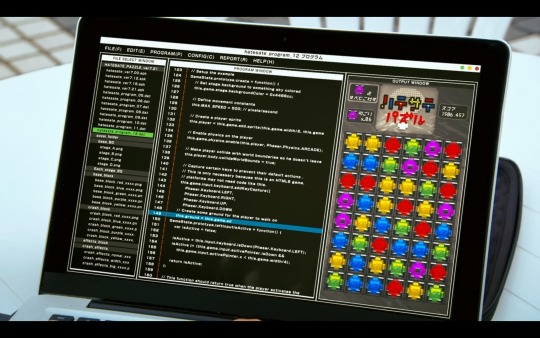
Hatesate Puzzle is an Android game – you can tell, because the list of files includes four different .apk files. Also, it’s up to version 7.21.
But the programming screen? Uses the same stupid block of text that all of the programming screens use in this show. Like, it’s even more egregious this time, because it’s shown very clearly, in decent lighting, unlike in Kuroto’s assorted lairs. Also, it talks about game physics such as collision detection for the ground.
This is a match three game.
Anyway, turns out Hiiro’s idea was to allow Tougo to leave the hospital, as long as he was still being observed. There’s a hundred thousand people infected right now, and the people who did it want him. So… Tougo is bait.
Needs of the many, blah blah blah you could have at least run this by someone, Hiiro. I get not telling Emu. But Asuna should have been informed, at least.
Almost immediately after Hiiro takes his leave, letting Emu take over, we hear static as Tougo staggers backward in his seat and passes out.
–––
We come to a busy office – a busy police barracks. Team Ghost waits anxiously on a visitors couch.
“I’m glad to see you’re back.”
Enter Officer Tomari Shinnosuke: Tokyo Metropolitan Police Department (active duty); Kamen Rider Drive (inactive).
Takeru and co had called in a favor, and Shinnosuke was only all to willing to help cover this case. Not only is it rider business now, but they’re threatening the city. Not to mention the police squad they destroyed yesterday – handily confirming that a day has, in fact, gone by – means Shinnosuke really wants in.
Turns out the three they’ve seen the faces of were all researchers into genetic therapy with the Next Genome Institute. Doctor Pac-Man is ‘most likely’ their boss, Zaizen Michihiko. Unfortunately…
They’re all supposed to be very, very dead. They died six years ago, as a matter of fact.
Most of the institute’s data was destroyed when the facility was sealed, but there’s a bit of closed circuit footage remaining of the event. Only a few seconds, but it’s enough to show them standing over an operating table, as orange lights encase and dissolve them, squares of light patterning the floor and walls.
Squares of light eerily similar to what they just say the other day, when people were activating Gashats.
Bugster work isn’t the only sketchy thing they’ve done – there were rumors of the institute working with cloning, creating mutants… basically, as Akari says, mad scientists.
(Anyone want to place odds on them being funded by Foundation X? No? Just me? Okay then.)
–––
Emu and Asuna are with Tougo as he wakes on a bench. THey’d moved him somewhere out of the sun, and he’s… An asshole about it. He never asked for their help, and he’ll die when it’s time, anyway, so why are they bothering?
Doctor Pac-Man, still very glitchy, strolls up. “He’s right. None of you are needed here. Why not just hand him over?”
Running time!
–––
Back at the precinct, Shinnosuke promises that he’ll let team Ghost know as soon as they find where the Next Genome researchers are hiding.
Y’know, except for that part where he’s too late, and they’re already going after Tougo, and by extension, Emu.
Shinnsouke’s fired up and ready to go after them.
Y’know, except for the part where Krim locked all of the Drive tech in his depression garage the Drive Pit at the end of the season, and Shinnosuke can’t transform, which Takeru points out, saying that it’s too dangerous for Officer Tomari to go.
Of course, Onari, logically, tries to point out that Takeru’s in the same boat right now, to which Takeru hurriedly shushes him.
Takeru and his team run off to deal with the situation.
Sad music plays as Shinnosuke laments his lack of belt.
–––
And here’s where I decided I had to cut the liveblog for now! Because again, twenty-some minutes, and nine pages of text. This is going to take a while.
See you next game
6 notes
·
View notes
Text
I gotta say I think my favorite part of Jeremy as a DM is that he takes the stupid half-jokes that I make offscreen and just. turns them into things for me. that also fit perfectly into the plot and the story seamlessly but feel special
like I was making goddamn jokes about “okay but. but I want a bloodsword. we do blood magic. please. Jeremy. Jeremy what if I could make my blood into a sword. b l o o d s w o r d. I could go to parties and never be unarmed because mY BLOOD IS A SWORD. YOU CAN’T DISARM ME YOU WOULDN’T PART AN OLD ELF FROM HER BLOOD WOULD YOU, SO LONG AS I HAVE BLOOD I HAVE SWORD.” and then, like. because it was only half a joke and I got attached to the aesthetic I actively started planning on how to make one of my own, which was pretty much going to be that there are some shadow weapon spells either on the cleric/oracle or witch lists and I was just going to take one of those as I was leveling up in Caedic magic and request that because it’s blood magic can we please flavor it descriptively as being made of my blood and not of shadows like, just as a cool aesthetic piece, and I’d have my bloodsword.
and then halfway through Book 4 Galen fucking Torus out of nowhere makes a really fucking rad bloodsword from his own blood and hands it to me and I kill a bunch of enemies of the Empire and feel hella cool and I go “c a n y o u t e a c h m e” with starry eyes the next day and he goes “okay sure” and starts teaching me how to make a bloodsword and there are cool bloodsword mechanics and just. Iria Strell got a bloodsword. after I spent six months joking about it. this is an actual legitimate bloodsword not a cheap knockoff made from a flavored shadow spell, real genuine Caedic blood magic here.
and, like, there are a couple of other obvious things (I spent a while being excited about a Feat tree that I’ve now totally forgotten because I think I was looking for some weird way to add Int to attacks and there was something similar to feinting you used bluff for a round and I’ve forgotten about it because it became irrelevant because Iria has developed mechanical combat spurs that give her a pretty similar option, not a “sooo then in five levels I’ll be able to do this!”) I guess another one was joking for months okay not joking about how much in love I was with Arcadia Dominus and holy shit she liked me back and the “gay murder elf bachelorette” bit actually becoming a part of the campaign, this campaign got literally infinitely more gay because I made a dumb joke and then Jeremy went “okay” and followed up on it, we went from no gay to one of the longest running and at least emotionally important plotlines is “oh no Iria is so gay you utter disaster fire of a lesbian how are you going to mess everything up now because Pretty Girl”
but, like
the one that is hitting me really really strongly now-now is that I have been half-jokingly complaining for months and months that I regret So Much Iria Strell’s background as a minor noble because it limits the fanciness and quantity of dresses that I can get for her and goddamnit I want to put her in all the shiny things all of them and how Painful it is to pass all these cool costumes that I Want To Pull just in fashion posts and stuff but uuurgh I can’t because Iria Strell isn’t the sort of noble who would wear all those and she kind of isn’t allowed and that just goddamnit I need to make a character next game who whatever the context wears Cool Clothes so that I would get to actually do a shit-ton of character design and costume design
and I am 1000% sure that this didn’t change from the original plans, like, the outlines have been in place for months well before I got obsessed with noble costuming, but the big objective of this book is Iria is investigating a maybe heresy/conspiracy that maybe involves nobles, and to do so, she has to go to a bunch of noble parties, and Galen Torus gave her an unlimited credit card and went “material resources are no worry go ham request whatever you want” and what her wardrobe is actively affects all the interactions she has with people and how well she can gather the information she needs to
which means that OOC I get the chance to design a full and changing wardrobe for Iria Strell to look cool as it is now her job as the secret leader of an investigation to actually do noble business and look pretty sometimes and talk to a bunch of nobles and go to parties but just. I’m limited in interesting ways by what is tasteful, but I have been given the full resources and an active in-character reason to utterly go ham on costuming, which makes me so excited as a person
and it’s just. super tiny details like this that idk make the games feel....more than just special? or maybe it’s that I’m not used to being listened to? like. the game is so good. I’m having so much fun. we have gotten to book 5 and it is once again the coolest fucking thing I could imagine. and so was book 4, and book 3, and book 2, and book 1. it is completely unnecessary to throw in tiny things like the bloodsword in order to make me happy and it is all done so....seamlessly? like. if one of my hunches is correct. the bloodsword and a ritual that Galen Torus performed telling Iria it would make her better at the bloodsword wHICH IT DID BUT THAT WAS NOT THE MAIN POINT OF THE RITUAL, THE MAIN POINT OF THE GODDAMN RITUAL WAS TO CONSECRATE PRIESTS AND PRIESTS HAVE MORE ACCESS TO BLOOD MAGIC SO A SIDE EFFECT IS BETTER THAN A BLOODSWORD BUT A CONSECRATED PRIEST IS A SUPER HIGH RANK AND THIS MAKES HER A CONSECRATED PRIEST AT AGE EIGHTEEN WHICH IS VERY VERY VERY UPSETTING TO HER AND POSSIBLY UNPRECEDENTED EARLY 30S IS CONSIDERED RIDICULOUSLY EARLY TO BE A CONSECRATED PRIEST FOR INCREDIBLY TALENTED AND FAST-CLIMBING CAREER-FOCUED NOBLES NOT A MINOR DISGRACED KIND OF EXILED LESBIAN DUMPSTER FIRE LIKE SHE IS
but consecrated priest thing aside and that being one way or another a major plot point and that coming so seamlessly and so perfectly a surprise from the fact that she asked an Exarch if he’d teach her how to make a bloodsword
again I’m pretty sure “Book 5 is noble politics book” was always going to be a thing so it’s not “oh Jeremy wrote it into the plot that I get to be ridiculous and pick out every single dress and everyday wear and hair and makeup for my character all the time multiple times a session and have that matter” because it was always abstractly going to matter as that matters as a part of being a Caedic noble but just
here and is everything I wanted and was everything that I was totally joking about for months except no joke I just. get to do it. which I’m just actively so excited about. I guess it just...feels weird to me because I’m... sometimes used to making my own fun? or just, like, making things happen in my own life? there have been way too many “well if you want to survive it’s only you that you can rely on” situations not even in a bad sense of my life is horrible like. I could go on a rant about how I....not don’t trust people as people but don’t trust people to be 100% reliable and so always make a backup plan so that if a person falls through I can still get what I need done to be done and it’s just more pleasant for everyone involved if I don’t pin pressure on people or things? but in a different way I do the same thing for the games that I’m involved in, I will find things to make me have Feelings and will make my own fun and write letters and befriend NPCs and insist on staying in touch and, like...I dunno I guess I’m not used to trusting any world, be it fantasy or real, to give me what I want, if I want a thing I have to carefully plan and invest time and energy to earn and take it and be prepared to fail and just because Jeremy’s my friend and I goddamn narrate everything jokes or not of how I/my characters feel and “okay but here is the 1000th picture of a cool dress that I’m sending you and because Iria Strell doesn’t get to wear cool dresses we’ll say it’s the Gothicus Maximus Spring 2019 collection” and just
I guess I’m really not used to a world that cares about what I want
and, like, is sometimes fucking brutal Iria is dealing with slowly losing her mobility and ability to fight to an injury that was her fault and she is descending into a lot of really fun mental health places that push fun buttons and Marian is spelljammer and is Marian don’t even get me started on Marian’s family suddenly reappearing or just. characters from the thousands upon thousands of words of backstory showing up but just idk it feels like even when things are really brutal to the characters......the world is still kind to me? it’s aware of what I care about and it cares about me?
and I’m just so not used to the world being kind
I don’t need the world to be kind to love it. I love this world even with how fucked up and hard it is, and I love the games that I play and the stories that I get to be a part of without them caring about me at all, I don’t need them to care about me, that’s not why I’m playing
maybe I’m just hella tired and the move has been awful my old housemate gave me a deadline less than 12 hours before when there was never a deadline in our original conversations and then she and her mother were also going through my room and my stuff I guess to try to determine how quickly I’d get out of there but, like, I do not like it when people go through my stuff and there was a scare about the landlord selling the new place and the new landlord would have to honor the lease for a year but then maybe not wanting me to have my cats so suddenly for two days even my new living place was up in the air and I was already jet lagged and stressed and barely slept to try to finish a week’s worth of work that I was under the full impression I had a week to do in a day and a half and definitely sprained my ankle but got to keep walking on it and internet took forever to set up and trying to fix my furniture and all my stuff is in boxes and I’m still walking around on a twisted ankle because it’s just me there’s no one here to help me, if I want things to be okay and to get done I have to make them be done myself and these boxes need to be unpacked by Saturday morning because the landlord wants to fix the floor and just. I’m stressed and emotional so maybe I’m hella overreacting to “oh you like costumes? well an aspect of this book is noble interactions and parties so sure I’ll let you pick out literally every dress that you’re wearing” but it just
it matters so much to me
Jeremy is really really good at the DnD thing
#have a long rant about my feelings and partially about dnd#I'm real tired#my life#gay murder elf bachelorette#I guess#this game is so fun and it keeps surprising me
6 notes
·
View notes
Text
Here's my stance: One, In general, Inquisition as a whole seems confused on what to do with Vivienne. Developer comments with regards to her development pin her as an advisor originally, and then reworked into a companion, with at some point the idea being that she had been poisoning Bastien. So development of her as a character did not really solidify between "viper in the grass" and "loyal companion if still aristocratic and upper class in comparison to our other companions." You see traits of both characterization in her portrayal, and the game doesn't actually take the time to try and distinguish which it wants to be the true Vivienne, or if the point is that she can be both.
And, unfortunately, fans kinda took this in the worst directions, with a certain segment favoring the "viper in the grass" depiction, and leaning in to that. BioWare has long been known to lean in to fandom takes on characters, take a look at Fan Service the DLC in Mass Effect, also known as Citadel. Hell, look no further than Alistair repeating "swooping is bad" in DA2. So this was how she ended up written in Trespasser, as a friendly viper, one that could be kept in check in the right circumstances, but still a viper.
Two, moreover... The Templars leashed to her and what that entails is still more than a little questionable, but... By nature, giving a mage the position of Divine, ESPECIALLY when the primary candidates at the time are Cassandra and Leliana and Vivienne pulls off this upset win, is a revolutionary thing. Maybe not a net positive, but a revolutionary thing. This changes the game Game. This is unexpected and unprecedented - a MAGE now has the pointiest of hats, a MAGE now sits on the Sunburst Throne, at the head of the religion that functionally rules Southern Thedas.
Whether or not it's what she's always claimed she intends to do with that power, whether or not it's what she would actually do, this WILL change things for mages across Thedas. Because now there is a mage in the highest position imaginable. To Vivienne, this is setting the example for all mages - "I made it, it's possible for us to ascend in this system." And it's saying that mages CAN be trusted with power - if she proceeds to rule favorably, particularly in the court of public opinion, the court that she says that mages were not viewed favorably in when it came time to rebel, and thus had the public against them, due to Anders, due to the rebellion, and now due to Justinia's death, if she can earn that favor, it then changes the game for mages at large. It just will take more time for others, while she is at the top of the pyramid.
Her reign as Divine might not enact progressive policies, but it still inevitably would have a progressive impact, by giving a mage power. Now, this can still turn sour, naturally, it's not like reasonable people given all the power they could ever desire and more don't lose themselves to that power and privilege. BUT... It's still setting the stage for some sort of change for the mages afterwards, and potentially being something that sparks change beyond Vivienne's practices as Divine.
The flip side of this, however, is that Cassandra is the LEAST change to the existing power structure. She's not a mage, and, while she wants to do good, we ARE talking about a woman who acknowledges that diplomacy is one of her short-comings, which... The Divine is an inherently diplomatic role, as the head of a religion that has political power AND stretches across multiple nations.
Cassandra, ultimately, changes the system the least. She has no intentions of changing the system TOO much. That while there should be some kind of change, she doesn't believe it needs SYSTEMIC change. She is the believer that the system is fine, it's the people who have corrupted it, and that is all that needs to be changed. She would change the faces, but not the doctrine. And, in being a non-mage, no particular change comes to the system even in just her in the position she attains.
Cassandra is the centrist, which in a lot of ways makes her even worse than the conservative, because she thinks minor changes are all that's needed, rather than systemic. Leliana is all about upending the system, and Vivienne's mere existence as a mage in a position of authority tosses the traditions on their ear. Cassandra keeps things as close to the status quo as they can be.

Full Confession Under the Cut due to Length
CONFESSION:
Some claim that Vivienne is a more progressive Divine than Cassandra, and I kinda understand where they are coming from. But also, it’s not really true. Both through rhetoric and actions, Vivienne is the one saying that some Circles were “too permissive” and that you can’t have “overly lenient Circles”. Vivienne is dismissive of Kirkwall, seems to handwave abuses, and doesn’t acknowledge if the “mages had cause to rebel”. Vivienne is the one that starts “a war to dissolve the College before it begins” and “brings down her fury upon them” (Which really goes against her “pitting mages against each other” dialogue). There’s the “Mages rise quickly in the Circle, more freedom and responsibility than ever before”, but this is only relative to the previous incarnation of the Circle (not Cassandra’s).
So literally anything better than that. She has her new Templar Order “leashed to her hand”, which is more promising, but considering “leash” has often been used as a synonym for “lyrium”, I’m a bit apprehensive about it. Not to mention in another world state, she can push the College of the Bright Hand out of the Circle that focused on “pushing for reform and close ties to the Inquisition”. So how much for reform is she really? (And so much for wanting to keep the Circles together) In every world state, she harasses the mages in one way or another.
She approves of an Inquisitor saying there needs to be mages in the Chantry, but even after she’s Divine, up to the Trespasser epilogue, she is the only mage we know of that’s in the Chantry. And on top of all that, there are no “reforms” mentioned that doesn’t relate to the Circle or Templars, either explicitly said or vaguely alluded to. Eventually, she “grudgingly” let’s the College of Enchanters be from the ranks of the Inquisition’s mages, though this seems to be more of a writing decision to reduce variance in world states for the next game than it does a genuine decision that Vivienne would make.
Cassandra on the other hand will say she only sees the value in restoring the Circles “Provided they fulfill their purpose. Too many have suffered since the mage rebellion began, but we cannot ignore the abuses that prompted it”. It’s Cassandra who will listen to Cole about abuses by the Templars on the mages, instead of dismissing them as “stupid, panicking mages” like Vivienne does. It’s Cassandra who extends out an “invitation” to rejoin the Circles to the rebel mages regardless of conscription or alliance. It’s Cassandra who will accept the mages refusing the invitation and becoming the College of Enchanters. So if the mages can choose not to join the Circles, how really confined are they to the Circles? That’s a big change. How much freedom and resources is Cassandra giving the Circle (and Vivienne) if they can apparently attack the College without permission? A lot I’d say.
It’s Cassandra that says the “Circle of Magi has its place, but it needs reform” which Vivienne never actually says. I have mixed feelings regarding the Templars rejoining the Chantry “on the condition that her leash will not be reattached”. Are they being given more independence (bad) or are they eschewing lyrium dependence (good)? As for the rest, you can actually have a conversation with Cassandra that wants a chantry more accepting of non-humans, which is better than nothing. Her epilogue will specifically mention that “the new Divine’s reforms are seen by some as going to far.” That “a new sect arises, demanding a return to the status quo”. So there are obviously reforms, and it’s not a return to the status quo. It’s hopelessly, unsatisfyingly vague, but it’s still more than Vivienne.
I don’t want either of these two to be Divine, I don’t want Chantry Circles or a theocratic military, but it seems undeniable that between these two, Cassandra is the more progressive one.
80 notes
·
View notes
Text
Well Made Futility: Infinity War Thoughts
I saw Infinity War for a second time and have some thoughts. SPOILERish thoughts, so, y’know, a cut here for the sake of those who care about such things.
I mean, I actually think this movie is better if you know what you’re in for going in, but I’m weird so what do I know.
So like... Infinity War is fucking difficult to evaluate. It’s a movie that does something completely unprecedented in film - while we all enjoyed joking about it, no single movie crossover has attempted to weave this many VERY different stories, characters, and (especially) tones into one coherent narrative before. It is a crossover unlike any other in film. And it’s mostly successful!
but
I know we all like to dunk on Marvel’s films because they’re popular and make a lot of money, and all of us have an inner hipster who hates things that are successful regardless of their actual quality or content, because fuck that man we’re not normies we only like things BEFORE they’re cool. But as a person who loves “genre” fiction - i.e. Sci-Fi, Fantasy, Horror, anything that isn’t set in standard reality - the Marvel movies have been kind of revolutionary. Genre films had gotten so LIMITED before Iron Man, and it was stupidly limited at that. We could accept that a billionaire fury who punches criminals could walk into a police department without making everyone burst into laughter, but we couldn’t accept that a strange chemical bath would permanently bleach a clown-turned-criminal’s skin. We could accept a guy getting powers from a spider OR a guy being really good at science but not both. We could accept a guy growing claws out of his hands, but god help you if that man also wears something other than black skintight leather. Everything had to be “grounded” and “real”, and I put quotations marks around those words because what they REALLY meant in the context of Hollywood was “boring.”
but
And then Marvel slowly chipped away at that. Not at first - Iron Man and The Hulk were about as restrained as the superhero movies that preceded them, but slowly the movies conditioned us to accept weird shit. Thor brought in Norse mythology and a certain kind of magic, although they dressed it up as “advanced science”, because we were in a transition and that was a concession they could make. Captain America took us out of modern day - a risky idea, period piece action movies are never a sure thing - and also introduced the idea of a serum that can turn you into either the ULTIMATE BEEFCAKE or a red skinned skeleton man depending on your moral compass, which is PRETTY FUCKING WEIRD when you think about it.
but
Then The Avengers happened. Before that movie came out, every conventional Hollywood line of thinking told us it would fail. Movies with multiple heroes don’t succeed. That’s why Batman and Robin sucked, right - too many heroes? And Batman and Robin, why, that’s the worst film ever! Spiderman 3 had too many villains! You can’t have more than two super powered guys in a movie - that’s just movie law! Having more than two super power guys is box office poison.
but
But The Avengers wasn’t. Maybe most of you don’t remember it because we’ve had 10 years of these Marvel movies and their success seems like an inescapable fact now, but The Avengers defied expectations by being both good AND a box office success - a ridiculously lucrative one at that! The Avengers took a huge fucking risk and it paid off.
but
Then it happened again. People assumed The Avengers was as weird as you could go. Critics were CERTAIN these movies would peter out eventually, that they couldn’t keep doing the impossible. One of these risks had to doom them. And a lot of critics looked at one movie on the post The Avengers slate - Guardians of the Galaxy - and said, “That’s the one - that’s gonna be the turd. A movie about a talking raccoon and a tree monster - two RIDICULOUS character concepts that sound more like jokes than something a studio would actually put in their action movie - along with some d-listers no one but hardcore nerds care about, all directed by a guy best known for gore-filled low budget b movies? That’s going to kill Marvel. There is no way that film can be good, much less a financial success.”
but
Guardians of the Galaxy was not just good, but it’s the best series within the franchise. Yeah, fuckin’ fight me on it nerds. (no actually don’t I’m voicing a subjective opinion in this paragraph I don’t actually give a shit about ranking movies like this)
but
Even when their movies weren’t game changers, they were still solid and fun. Whether or not they’re your cup of tea, Marvel’s superhero movies are never worse than “good.” Some of them are “great.” Some, like The Avengers, Guardians of the Galaxy, and Black Panther, are arguably transformatively great. At the very least, these films taken as a collective whole have changed the way we approach Genre Films. They have redefined what is possible - they reminded Hollywood that suspension of disbelief is a malleable thing, even if some studios haven’t quite grasped the concept yet.
but
Which brings me back to Infinity War. Like The Avengers before it, Infinity War brings different characters from many different stories with many different tones and styles and, to an extent, genres/subgenres, and blends them into a coherent and emotionally resonate whole. It requires you to have seen at least the majority of the previous DECADES worth of movies to work, but that’s not a flaw - no more than, say, the twentieth chapter of a novel requiring you to read the previous 19 at any rate. Infinity War needs those previous films to function, and to its credit, it not only uses what they built, but does so in genuinely surprising ways. You didn’t think you needed a Rocket Raccoon/Thor team up in your life, but this movie proves you did. You also didn’t think you’d see Rocket Raccoon genuinely reach out to Thor (who, to him, is a relative stranger) and try to help him through his grief, but it happens, and it’s a legitimately interesting moment that movies both characters forward in their respective arcs. This movie is more than just taking a bunch of toys out of a toybox and smashing them together (though yes, there are parts of it that are very much that - these are action adventure movies, after all). Characters develop and bounce off each other in glorious and meaningful ways. There is a weight to everything beyond the obvious, mercenary Hollywood mandate to make as much money as possible by getting fans of all these different franchises into one theater.
but
The movie even tries to rectifies some of the franchise’s most notable flaws, in particular their lack of decent villains. You could count the number of actually compelling and interesting villains from the previous 18 films on one hand. Thanos, the big bad of this film, finally gets us to the other palm. His motives are understandable but NOT justified - that is to say, you can understand why a person may believe what he believes, but at the end of the film you know for a fact he’s wrong. Thanos is a bad guy whose evil plan will destroy countless lives, but he manages not to be the cartoonish caricature of a villain whose over the top “destroy the world” motivation makes no sense. It’s nuanced, is my point. I don’t think he’s the best Marvel has offered us - he wouldn’t crack my top three just yet - but he’s miles above most of the competition.
BUT
So here’s the crux of my review. When I got to the ending of the movie - an ending that, admittedly, I spoiled for myself ahead of time, because I do that for most movies ever since I got majorly burned by Jurassic Park III when I was a teen - I couldn’t stop thinking about it, because it’s... it’s a paradox. Not just the ending, either, but the whole movie. This is a film that both does and doesn’t work. It is both an amazing feat and... and fundamentally broken.
And it all has to do with those 18 films before it.
Ok, so: if taken as its own story, that is to say, as just it’s own thing, not the part of a greater whole... then the ending of Infinity War is exactly the ending this story needed. This is Thanos’s story more than anyone else’s, when you get right down to it, and from the perspective that this movie is meant to tell his story and his story alone, the ending is the only one that would fit. Thanos gets everything he wants, at the cost of everything that mattered to him. His crazed vision finally comes true, and the audience feels the full weight of how horrible that is. That ending - that maddening, confounding ending, where almost every hero we’ve come to love over 18 goddamn films is killed with the snap of his fingers - shows us exactly why we can’t let monsters like Thanos come to power, and how even the monsters like Thanos himself are destroyed by following those mad dreams through (a point reinforced by the cameo of a long forgotten past villain, Red Skull).
However, as I said before, you really CAN’T take this movie on its own. Structurally it DEPENDS on you seeing those previous films. You have to have seen them just for this movie to make sense, and to be emotionally affected by it you must also have cared about those movies and their characters. This movie is a sum of those parts.
And as a followup to those 18 films - as a part of their greater whole - it fails. So many characters we followed and love - Black Panther, Spider-Man, every fucking guardian of the galaxy except Rocket and maybe Nebula if we count her, just to name a few - is killed off in a literal instant. With the exception of Loki, each of these deaths kind of renders their preceding journey pointless. Peter Parker was just starting his journey in his preceding film - so was Black Panther, so was Dr. Strange, so were many of the others. Imagine if Hamlet was killed in act 1 of his play - everything about him would be unresolved, and all of his supporting cast would have no anchor to the plot since the conflict they’re involved in is removed with Hamlet’s death. You’d have to start over. Other characters are farther along, but with rare exception, none of them had what could be called a satisfactory end. If the deaths in this movie actually hold true, then most of the preceding 18 movies have been broken. They are wastes of time.
Of course, a savvy person would note that literally every character killed in this movie has been cast in the next Avengers film, due out next year. Spider-Man and the Guardians have announced movies with release dates after that one, too. Black Panther’s sequel has been announced although the release date has not. These deaths are highly unlikely to stick.
BUT if that’s the case, well... then this movie’s broken again, because now that ending has no weight. Now that ending is pointless - in fact, this whole movie is, because it’s all just going to be undone by the next. Either this film was a narrative waste of time, or the preceding 18 were. There’s no other option.
...but...
There is, I suppose, a possibility. A faint one, admittedly - I have no idea if they can achieve it. There’s a possibility the fourth Avengers film could find a way to make this movie’s weight hold while still putting all those dead characters’ stories back on track. Infinity War was conceived as a two part film story, after all, even if they dropped the “Part 1″ label come release. No matter how much this film wants you to think otherwise, it is just part of whole - and maybe, just maybe, the second one will make the first work WITHIN that whole.
I don’t see how it can, but then, I didn’t see how they could make me care about fuckin’ Rocket Raccoon. And Guardians of the Galaxy is, as I said, the best one.
If I were a betting man, I’d bet on this movie ultimately being a narrative cul de sac - a very well made, but ultimately pointless entry that is invalidated by what comes after it. If that ends up being the case, then that’s kind of sad - but there’s a chance they may make it work after all, and if I’ve learned anything, it’s not to bet against Marvel.
19 notes
·
View notes
Text
Some older post finale Gravity Falls headcanons (most pre journal 3)
Bill Cypher is a recipe for Tulpa based about knowing things and mysteries. However every shaman/user ends up with him/her/it screwing them over to take a body or set up some calamity.
It is like the chaos gods in that its alive but unborn until it FINALLY (by cheating) pulled off a breach during Weirdmaggedon.Bill's nature is why he's so reflective of Both the Elder Pines. Namely looking akin to Filbrick while having the obsession and mystical self stylings of Ford and the conartistry and disdain of empathy and so on of Stan.
Mind he doesn't know this, or if he does doesn't like to think of himself that way than you or I think of ourselves like a bunch of genes, meat, bones, and etc that accidentally things we're special.
Technically Cypher is born and dies with each summoning and banishment though recalls and pick up from the previous interations (one life having skin puppets) He lost this ability when he took physical form and moved out of the Mindscape or would have.
The current one we know has been semi-active, as he wasn't formally banished, for 40 years an unprecedented time with no interruptions, hence his greater success.He is naturally to reform but without use of the spell this could take at minimum 30 years, likely more with the destruction of any image or symbol near his body which he MUST now remanifest into.
This is helped by the function/being known as Axoltol, though because Bill has sooo much bad karma from bad deals and technically is trying to break a fulfilled one.
Bill was let into the mind of the person he agreed to and attempted to renege on the deal to harm STan's family when he got what he asked for, its why he couldn't break out along with the mindspace dissolving around him
Stanford was overly dramatic, he could have just set the raygun to "Bill Cypher" though likely didn't know this as he didn't realize how LITTLE Stan knows Bill.
Incidentally this is why with Stan's mind coming back Bill hasn't there isn't as much rooted memory to pull from as his own mind/life.
The full mindwipe has put Bill down considerably and without outside intervention its a Loooooooong reconstitution for Bill.
The Zodiacs are his power, his key, his bane, his rivals, and his source. Its complicated.
The human energy circuit would have trumped Bill and thus he could be banished, permanently negated, enslaved, or had his essence, knowledge, power (everything that makes him him) divided to the Zodiacs or something they want.
The Zodiacs are less the individuals so much as mantles. Some being the symbols resonating traits onto the individual, some being traits that resonate to the symbol.
Switching the visible marker of the symbols changed and freed the Zodiac characters who did so to grow and change and resolve themselves. Some have grown and resolved their issues.
Others, like Robbie, are still a bit to go but can if they wish.There are always multiple canidates though some better than others for a symbol.
Soos still qualifies for the Question Mark but so does Melody but he also is Big Fish like Stan.
Transcendence could have still happened, if Bill's powers are being converted, ala a tree does a corpse/mulch into the powers for a Zodiac which will be minor and liminal until charged up, possibly by uniting iwth others, exposure to supernatural magic, or other triggers/empowering. Each one will develop supernatural abilities and so on based on themselves AND the symbol.
Dipper is going to summer intern or do the apprenticeship more as a after school thing to test things out.
Ford is reacclamating though is borrowing money from the newly enriched Fiddleford.
Stan is managing Fiddleford's estate and earnings and so on.
Demon Guardian AU is sort of true. There is a Duane, Dot Matrix, and so on. Though they are locked in the dying dimension of Bill
Bill's dimension isn't "dying" just the parts he has touched are devastated. With his defeat his influence even there is waned and the henchmaniacs, depowered because they were tied to Bill, are being rounded up.
More than GF and that dimension was saved.The spacecraft's systems are highly automated and out and date. It will take a long time, but not as much proper stellar understanding would tell, but extraterrestrial civilizations have been notified and signaled due to the events of Ford's capture in Dipper and Mabel vs. The Future.
With the events followed cursory examination (hmm ancient penal probe signal.. nothing big just a standard scan and ping back and WHAT THE FUCK A Class X breach with no limit. A Celestial level entity with stable temporal signature and armies of chrono-teched agents. And what's this thing A WAR one of them killed the other. Holy FUCK, call the boss this needs a full on Investigation and Research TEAM)
Even with the wrap up people out there will want to land and find out just what the fuck is going on. especially learning that the P-drive has been leaking for a near geological scale of time having who knows what effect.
Likely we've already seen them (Lefty) but more are on the way. We've caught attention and while it won't happen all at once GF Earth isn't going to be completely ignored
2 notes
·
View notes
Text
S3 Sucks Big Time And I’m Tired Of It.
Hi y’all. Next chapter’s well underway! In the meantime, there’s something I need to get off my chest, and this platform seems like the perfect place to do it.
SVTFOE season 3 has been the worst possible direction that the show could have taken. Out of all possible scenarios, the only way it could possibly get any worse is if all the problems that have been created in the past dozen episodes were, from here on out, totally ignored as the show tries to backpedal its way out of this conundrum.
The season’s complete trainwreck of petty drama, plot regression, character devolvement, and tonal problems is so complex and varied that it’s almost impressive, because of all the parts that seem like mistakes, the most glaring issues seem to be deliberate choices by the writers.
This starts at the beginning of S3 with the Battle for Mewni, and continues on through the season, to the point that there isn’t an episode in which it’s not present. Let me go ahead and dive in here, and just explain some of the myriad of things that are wrong with what’s been produced thus far.
Tone - mistakes and choices.
Right from the beginning of the Battle of Mewni, all of the show’s tonal problems are thrown up into your face, over and over again.
The purpose of story tone is to help the story retain focus, both in the direction you’re heading, and in helping your viewers know what to expect from the show. It informs the actions of the characters, and helps you to understand how to feel about certain things that happen. There are a lot of great examples of how this works in modern cartoons.
Most appropriately, Avatar: The Last Airbender, Teen Titans, and Gravity Falls are all very obvious examples of this. Each series’ tone is constant and lets you know what to expect from every episode, and more relevantly, features a mix of serious, character-driven narrative progression, while also allowing room for each series to tell jokes, show off the lighthearted interactions between characters, and have those personal moments of heart and meaning that mean everything when forging a bond between yourself and the characters you’re watching.
SVTFOE has always had problems with tone, from the introduction of Toffee onwards. Toffee himself is a perfect reflection of what the problem with the show always has been. He’s a character that wants to be serious, with real meaning and consequence, but the show itself is very goofy and lighthearted, and only in his presence is there any sort of continuity for the first two seasons.
This problem is thrown into overdrive with Battle For Mewni, which creates a world-shattering conflict that the show just isn’t prepared to handle in any capacity. The conflict itself is world-ending stakes, with Toffee’s plans finally coming to fruition - not only is the kingdom of Mewni in shambles, but he’s draining all the magic from the multiverse.
Despite this, though, the show’s goofy tone and ridiculous antics sabotage this more serious, tension-filled plot, over and over again. This continues until the parts that actually have tension, like Star drowning in the magic dimension, Toffee’s return and death, Ludo’s transformation into a horrible dictator, are not only undermined, but actually feel completely out of place in the context of the show.
One minute the show is telling you how funny and ridiculous it is, like with the parts that show River trying to run the kingdom, or anything involving the dungeons or Marco’s “vigilante pranks,” and the next minute, it’s demanding you sit up and watch, because world-ending consequence is crashing down in a manner completely unprecedented.
This problem continues into the season, long after Toffee’s death, with the conflict between the goofy elements of the show, and the more serious angle of princess that Star obviously wants to become.
First, it should be noted that the writers did at this point FINALLY make a conscious choice about the tone of the season/series - they did it when Marco arrived on Mewni in “Lint Catcher.” It happens in the most jarring way possible.
The series until this point has been all about lighthearted choices and fun adventures, so you’re led to believe that when he gets there, you’re going to see an emotional reunion, a return to the status quo, and a setup for next week’s fun antics. The setup feels as though the show is saying “okay, we’re going to do what we did before, but on Mewni now.”
Instead, it’s apparent immediately that Marco’s made a huge mistake. He burns the bridges he has left on Earth. Meanwhile on Mewni, Star’s not so much excited or even happy to see him, as she immediately seems as interested as possible in making sure he isn’t around for reasons that are never actually directly stated.
This is the tone that the series sticks to for nearly the rest of the season - Star being selfish and emotionally distant while Marco acts as a third wheel - and as far as a conscious choice for tone goes...
WHY???
This is the first issue because it’s really the underlying problem behind why I don’t enjoy S3 at all. It’s not written to be enjoyable. The tone of the show is “mistakes which have no resolution,” or perhaps “actions have consequences,” but unlike, say, Adventure Time, which shares this theme BUT is drowning in interesting side-plots and settings to draw focus (since “adventure” is also a primary theme of the series), that tone is taken and crammed down your throat at every opportunity.
That’s not to say it’s consistent, though. The show attempts to break through this tone on multiple occasions, with the immediately following episodes, Trial By Squire, Princess Turdina, and Starfari attempting to show that no, this is not the way things will go.
Despite this, though, the tone is so present in Star’s more serious attitude, in her dynamic with Marco, and in his own actions (and continuing, progressively worse series of mistakes) that I’m left wondering “what the heck am I supposed to be feeling right now?” Trial By Squire, like the other Quest Buy episodes, is excellent, but in no way am I prepared to invest myself back into Marco and Star’s relationship when they themselves have turned it on its head in ways we aren’t even seeing yet. The theme of the season is “consequence” but nothing actually seems to have consequence. You just feel bad after watching, because somehow you’re more aware of what the characters should be going through than the characters themselves.
Plot - how to story.
Like with tone, SVTFOE has always struggled with plot. One minute you’re getting a lore-packed episode like St. Olga’s, or a compelling character narrative like in the episodes preceding The Battle For Mewni, and the next you’re getting completely disconnected adventures like the Quest Buy episodes, Interdimensional Field Trip, etc. etc.
Up until now, though, the show has always done a pretty good job on both ends. Some of the filler episodes are annoying (Fetch/Star on Wheels will forever remain “the block that should never have been produced”) and some of the plot-driven episodes don’t always land (Baby is great, but also the most out-of-place episode in S2, IMO) but generally speaking, things have always tied together in the end. If not that, then it’s at least fun to watch.
So then S3 starts out by killing the antagonist and central conflict before we even see them emerge, and then continues onwards as if it still has a reason to do so. Then it introduces a theme that is like nails on a chalkboard for trying to build something to be around and watch. Talk about shooting yourself in the feet!
Throughout S3 so far, we’re given a bunch of characters that are changing radically, but no reason for their change, and no motivation to get them to show that development. Star is trying to change into a more down-to-earth, serious princess, but it’s not until Starfari, nearly a third of the way into the season, that we’re even given a glimpse of a conflict which suits this mindset.
Meanwhile, Marco’s trying to come to terms with who he wants to be in life, but whether he was on Earth or on Mewni, post Sophomore Slump, the series itself would not have been affected at all. It’s like he’s totally isolated from everything that’s going on around him, and any time he tries to have an impact or take control, things blow up in his face.
Eclipsa is introduced as a full character to show off a moral grey area and try to influence Star into her “do what you want” lifestyle, but there’s no catalyst to show this change at all, and as a result she, too, could be completely cut from the season to literally no effect.
This is not how you do plot. It’s not how you do a story, and it lends itself to the theme of the show, because now in addition to “mistakes without resolution,” and “actions have consequence,” (via Star’s attitude), the entire season thus far has had a running theme of “pointlessness.” The only conflicts which you’re driven to care about at all are those between characters, but even those are so poorly managed and difficult to understand that you just want the series to tell you what it’s trying to do, already.
Killing off Toffee was, in my opinion, the biggest waste of a character that I can think of in recent memory. It’d be like if Aang defeated the fire lord at the end of book 2, or Bill Cipher showing up and being beaten halfway through Gravity Falls.
I expected the show would at least provide a reason for the defeat so we could move on - like a “now that he’s gone, we can do this other thing that we really want to show” approach, but that just hasn’t happened. These characters still have so much growth to go through, the story still has so much to tell, but we’re just missing any driving force behind the plot, and as a result, the only really interesting bits of the series (the relationships like what are shown in Lava Lake Beach and the story development like in Deep Dive and Monster Bash) fall extremely flat while you wait for a reason for their existence.
Characters - unjustifiable and unlikable
Okay, so we’re seeing a running theme: inconsistency. The show likes to jump around with plot. It likes to have a few different themes. And up until now it’s liked to jump around with characters, too.
But this season actually introduced some consistent characterization for Star and Marco, with Star being the more selfish and serious version of herself, and Marco being a walking pile of bad life choices and personality shortcomings.
So, again, we’ve got a conscious choice by the writers that makes NO SENSE.
That is to say, we’ve now got consistent characters and they’re awful.
The biggest thing that you need from a character in any show is a WHY and a HOW.
The WHY is the reasoning behind their existence and character from an out-of-show perspective. It creates a relateable backdrop/canvas for the character to act on. Zuko’s struggles with honor, family, and his own duality are is WHY. We understand who he is and WHY he acts the way he does, and as a result, despite him making some terrible choices and being full of angsty late-teen drama (”nobody understands me mom! I mean, uncle!”) we still sympathize and know where he’s coming from.
Then there’s the HOW, which is the reasoning behind their actions WITHIN the show. Zuko’s driving force is to capture the Avatar, which is HOW that out-of-show WHY backdrop manifests. All of his problems come to a head and he’s created a simple narrative solution: if he can just capture the avatar, things will get better. Despite his antagonism, we understand him and appreciate who he is, even if we don’t want him to succeed. The problem with S3 is that it creates a problem that the series never really had before. The characters were never particularly consistent or driven, and when they are (like Star in Storm the Castle) the motivation was adequate. Star wants to get her best friend back. As soon as the stakes are raised from a character perspective - as soon as Star and Marco become consistent and show signs of a progression path - the show falls apart, because we’re not given any justification for it at all. The WHY and HOW behind Star’s actions in S3 is a total enigma, because the show never actually tells us her line of reasoning. The best I can come up with is that she feels the need to be more responsible following the problems her previous actions caused, but there’s been nothing in the season that requires that attitude at all. The actual stakes behind what’s going on in the series as a whole are actually lower than they’ve ever been, so why is she now choosing to be serious? She has no WHY because we don’t know WHY she’s acting that way, and she has no HOW because we don’t know HOW that new backdrop is guiding her actions. The result is this character that’s just designed to be unlikable. Star in S3 has treated her friends like crap, has been emotionally distant, difficult to understand, selfish, and irresponsible, all of which is now superimposed on a character we don’t understand. She was most of those things when she was bubbly and goofy, too, but we understood it! She just didn’t understand responsibility, and more importantly, she learned after her mistakes. Most importantly, the show did not ever demand us analyze her actions. S1 and 2 are stuffed full of apologies, emotional connections, trials and triumphs, and problems with solutions as she comes to terms with the idea. We don’t have any of that now, though, we’ve just got all the problems with none of the solutions. Likewise with Marco. You can understand his motivations a little bit better despite them never really being said at all (the WHY is that dude’s seriously misguided on what he wants out of life), but the HOW is still totally missing. He just stumbles about, not really learning anything or trying to understand why his life’s so messed up at all, and as a result, I just feel sorry for him. By the time his surprise party blows up in his face in the holiday special, I just want to reach into the show and tell him to stop trying. He doesn’t seem to be aware of what he’s doing, most of the time, and completely ignores the consequences of his actions. We understand WHY he’s so misguided, but we don’t understand HOW he’s continuing to act that way. So here we are. We’ve got a season with unlikable characters, no central conflict, and a depressing, scattered theme. This brings me to my final point.
Bullshit Drama - conflict vs. adolescence
In the absence of the villain, we’re left with the ultimate in adolescent, petty drama, as all these characters without understandable motivations or conquests scurry about, trying to find a way to make the show compelling while also maintaining the awful tone that this season’s chosen.
So we’ve got petty drama. Character dynamics without weight. Arguments with no meaning. A bunch of relationships which are built around a poorly-constructed love-triangle which is both completely unwarranted (this coming DESPITE me being a fan of Tom, this season) and unprecedented in the series as a whole.
The writers’ apparent obsessive need to use this BS “Dramabox” mechanic in place of any real plot or direction informs the entire season. Everything is building up to further defining the completely fucked-up relationship that Star and Marco now have, to creating conflicts between characters that could be solved with some half-decent communication, to backpedaling character growth (poor Tom, he’s tried so hard) in the interest of producing something that you can gossip about in a schoolyard.
The thing is, you can do drama without resulting to this. It’s one of the reasons you have an antagonist. As the plot drives the characters together into new situations, they won’t be comfortable with it, or with themselves as they’re tested. They’ll chafe as they adjust, and ultimately, come out as better people in the end. The subtle conflicts between Dipper and Robbie, or Grunkle Stan, the disagreements between Toph and Katara, Starfire’s bubbly surface or Beast Boy’s nonsensical nature compared to Raven’s dark, down-to-earth personality... these are all examples of well written character drama. Two informed characters trying to adjust to one another as they’re pushed forward by circumstance.
But instead we’re left with pointless adolescent bullshit. The kind that gets nowhere, it’s just something to talk about. “Did you see how annoyed Star was with Marco?” or “God, look at how bad a friend X is to friend Y, they’re just awful...” It’s schoolyard gossip and it completely disgusts me.
The most frustrating thing is, Eclipsa’s still a character in this show. She is the person to tell Star to get her shit together. Like, oh, maybe instead of running away and buying your feelings for your friend, you should confront them? Maybe there should be a balance between having fun and being serious? These are both things that a real person, particularly a mentor, would say in a real conversation, especially around the circumstances of S3. But that would be too easy, and kill the only motivation that the show has left to crawl forward!
So instead we’re gonna sit here and watch Marco fight with Tom over Star, for some contrived, bullshit reason. Because there’s nothing better for them to do.
Overall, this show has just about run its course for me. It reminds me of my short stint with the Walking Dead, where over time I gradually just... stopped caring. I’ve told myself I’ll see through another few episodes, and I’m going to continue writing my story regardless, but there’s a point where I just can’t be bothered anymore, and I think it’s approaching fast.
7 notes
·
View notes
Text
How to Maximize Your Replay Abilities in Tekken 7
Tekken 7 is the seventh installment in the much-renowned fighting game franchise of Tekken. It is one of the legends of the industry with a considerable fan base, and the latest game in the line was a massive success due to its new game mechanics and graphics updates. Tekken 7 took significant steps to increase the appeal of the game to the masses by bringing in old and new characters into the fray. This automatically worked as it gave the game a lot of re-playable value and gave the players a thousand different customization options. All of these put together, Tekken7 was a massive hit with cult fans and followers and also with new players who just came into the genre for the first time.

The latest feature added to the popular fighting game title is the new replay feature. A common addition to most fighting games, the replay mechanic opens up almost endless possibilities for improvement. With a chance to practice and further look into everything done by the player, it holds the potential to improve even the worst players’ game if worked with properly.
REPLAY FEATURE
Introduced for the very first time in Tekken 7, this feature in the gameplay means precisely what it says. The replay feature helps you to look into the fight after it is over, although it might seem like a drag onto your game, using it makes more sense. There are a lot of different characters in Tekken 7, and that results in seemingly unlimited combinations of fighting styles. And one of the significant aspects of fighting games is to study the moves of your opponent. Before this feature, the only way to do it was to lose over and over again, but now you can watch the fight in multiple settings using it to your advantage to gain the upper hand in the next upcoming fight.
By watching matches that you either won or lost, players determine precisely what they lost to in a given matchup whether it be learning how to deal with Eddy’s gimmicks or that side-stepping Kazuya to the left shutdowns his offence. Using this replay system to learn lessons from tough matches is what separates the best players from the worst. Regardless, getting frustrated over losses is a common thing, but using the replay system to study where you went wrong gives you an opportunity to hone your skills to try for a win in the next match.
USING THE REPLAY FEATURE TO YOUR ADVANTAGE
This new feature allows for an unprecedented amount of potential knowledge to be attained, which was not available in any of its previous versions. Although the replay system is majorly used to look back about what you did wrong, instead, it can be used equally as effectively about what you did right. Honing your skills over and over again by refining what you are good at gives you a significant edge over your opponent in online matches.
Whether it be noticing how a particular combo string is difficult to punish, or your ability to mix up mid hitting attacks with low hitting attacks, or how well you utilize throws in your game plan, there is always something to be taken from your gameplay. Everyone is good at something, and to use the replay system just to look at defeats is not fair to the player. Improving your skills through knowing what you can do better or by learning something new, the new replay feature in Tekken 7 has you covered.
I’m Emma Justin . I’m a web developer living in USA. I am a fan of technology, entrepreneurship, and web development. I’m also interested in education and writing. You can visit my company website with a click on the button above .
Source: https://brownpilot.com/blog/how-to-maximize-your-replay-abilities-in-tekken-7/
0 notes
Text
Arsenal’s stress is just beginning as Aubameyang, Saka, Lacazette need new deals
LONDON — The announcement that Arsenal had agreed a 12.5% pay cut with their playing staff initially appeared to be a victory for everyone involved. Here was an example of a group of highly paid and much-storied footballers, routinely maligned for existing in a bubble of exorbitant wealth, recognising the reality of the world and making an economic sacrifice for the greater good during exceptional times.
In doing so, the Gunners became the first Premier League club to confirm a salary reduction as opposed to a deferral, setting an example to others by demonstrating both the severity of the financial damage this coronavirus pandemic will likely inflict and an admirable collective willingness to face that challenge. By saving a maximum of around £20 million over the next 12 months — their salaries are repaid in full if they qualify for the Champions League, or 7.5% is returned upon reaching the Europa League — the reduction meant that the club’s non-playing staff were less likely to be furloughed.
– Stream new episodes of ESPN FC Monday-Friday on ESPN+ – Stream every episode of 30 for 30: Soccer Stories on ESPN+
And yet, the negotiations also shone a light on the internal tensions in the Arsenal squad that pose one of the biggest sporting tests to head coach Mikel Arteta as he rebuilds this team.
Contract negotiations have long been an issue for the Gunners. It’s why the club sought to bring additional expertise on board, including former Team Sky lawyer Huss Fahmy and Raul Sanllehi from Barcelona. Yet despite the goal of injecting greater diligence and ruthlessness into their operations, the Gunners conducted their pay-cut conversations against a backdrop of uncertainty surrounding the futures of several influential players.
Arsenal have been in a rebuilding pattern since Arsene Wenger left in 2018 but it seems like the same problems with keeping top players and successfully renegotiating contract extensions await them when football resumes. Stuart MacFarlane/Arsenal FC via Getty Images
Upon taking the helm after chief executive Ivan Gazidis’ departure for AC Milan at the end of 2018, Arsenal head of football Sanllehi and managing director Vinai Venkatesham underlined how they wanted to establish fresh business practices following the end of Arsene Wenger’s 22-year reign and a large-scale restructuring. “Internally, we are calling this period ‘The New Chapter,’ which I think says a lot,” Sanllehi claimed in November 2018. That sea change had multiple components, chief among them a need to improve the club’s methodology around contract negotiations, with the Gunners having lost an array of talent on unfavourable terms. In 2019, Aaron Ramsey joined a painfully long list at the end of last season after the club withdrew a longstanding offer to end what they privately vowed would be the last stalemate of its kind.
2 Related
“You should try to always avoid going into the last year of a contract for many different reasons, from the club’s side and also for the player,” Sanllehi said. “We will try to get clarity earlier.”
Yet a cloudy picture persists, and more than a year later, that search for clarity continues. Pierre-Emerick Aubameyang, Bukayo Saka and Alexandre Lacazette are among a number of players facing uncertain futures, amid the metaphorical clock ticking and growing speculation over exactly the sort of cut-price departure Arsenal wanted to avoid. Aubameyang and Saka are out of contract in 2021, Lacazette in 2022.
– Sources: Ozil facing uncertain future as contract talks stall – Laurens: Inside Arsenal players’ pay cut negotiations
A partial explanation for the delay in tying players down can be found in the upheaval caused by Unai Emery’s departure in November. The Spaniard’s tenure unravelled to an alarming extent, but the club were so reluctant to sack him that there was no immediate replacement lined up. The club opted to give club legend and assistant first-team coach Freddie Ljungberg a chance to prove himself. The Swede had an excellent relationship with Arsenal’s young players from his work as U-23 manager but failed to address the tactical issues that contributed to Emery’s departure. Having held an interest in Arteta when Wenger departed, the Gunners opted to appoint the Spaniard in mid-December.
But as the coronavirus spread across the globe, causing mass disruption to daily life and presenting unprecedented challenges, discussions inside the club turned to cash flow and Arsenal found themselves in the awkward position of having to simultaneously present competing arguments to certain players. The spirit of those conversations was awkward: We need you to take a pay cut to safeguard the club’s future, but also believe us when we say we’re in a position to compete for trophies in future … so why not sign a new long-term contract?

• When does the transfer window reopen? • Karlsen: Possible coronavirus impact • Best ever transfers: 100-51 | 50-1 • This summer’s top free agents • January transfer grades • Latest completed major transfers
The most obvious example of a player caught at the crossroads is Pierre-Emerick Aubameyang, who will have one year remaining on his existing contract whenever the current season ends. The striker turns 31 in June and his next contract will probably be the last big deal of his topflight career. He’s in a strong negotiating position, having shared the Premier League Golden Boot with Mohamed Salah and Sadio Mane last season before backing that up with 17 goals this term, second in the standings behind Leicester’s Jamie Vardy.
Aubameyang’s haul is especially impressive given the team’s broader struggles under Emery. The Gunners’ all-time record goal scorer, Thierry Henry, echoed the sentiments of many supporters when reflecting in December: “Without the goals of Aubameyang I don’t know where we would have been right now.”
No other Arsenal player is in double figures, with Lacazette next best on seven league goals and Nicolas Pepe with four. To underline Aubameyang’s talismanic effect on the squad, Aubameyang was given the captain’s armband when Granit Xhaka was demoted following an altercation with supporters. The striker used his programme notes in January to scotch rumours of a possible departure, adding: “I am committed to it and desperate to bring it back to the top, where it belongs.”
However, there are some senior figures at the club who, while welcoming that public show of loyalty, would have liked to have seen a stronger indication from Aubameyang that he is ready to sign a new deal. Talks have been delayed as a result of the coronavirus, but already it was understood that Aubameyang’s position involved waiting to see whether the club qualified for the Champions League and how well-placed they were to fight for silverware during the theoretical apotheosis of his career.
All of which is difficult to square with Arsenal being the only club to take a pay cut — and one lasting 12 months at that, rather than the three- or four-month deferrals reported at other clubs. Aubameyang’s future is undecided, but other clubs including Chelsea, Barcelona and Inter Milan sense an opportunity he could be tempted away.
Aubameyang’s future feels most precarious at Arsenal given both the leverage he has as the club’s top scorer and the fact that he has only a year remaining on his deal. David Price/Arsenal FC via Getty Images
Saka is at the opposite end of the spectrum in terms of age and influence, but finds himself pondering a similar dilemma. The 19-year-old has been one of Arsenal’s success stories this season, breaking into the first team with maturity, consistency and quality — form made all the more remarkable by his doing so largely while playing out of position at left-back rather than in his preferred guise as a winger.
Like Aubameyang, Saka will have one year left on his deal, and with just 26 first-team appearances under his belt, he already has attracted interest from a host of clubs including Borussia Dortmund in addition to being namechecked for a future international call-up by England head coach Gareth Southgate. He joined Arsenal at the age of 9 and is deeply fond of the club, but rivals will make a compelling case that they’re better positioned to aid his development.
Saka earns a fraction of Aubameyang’s £200,000-a-week wage and would therefore feel the pinch more acutely over the next year, but this isn’t about the money as much as it is ambition.
play
1:42
Gab Marcotti explains why Premier League clubs are hesitant to resume the season.
Arsenal undoubtedly need considerable investment to help them compete again for the Premier League and Champions League. Sanllehi and Venkatesham are engaging characters with the club’s best interests at heart, but do they have the resources to create the conditions for the Gunners to challenge? And if not, will owner Stan Kroenke buck a trend and invest to help bridge the gap?
These are the types of issues Mesut Ozil felt did not get satisfactory answers before declining to join his teammates in taking a pay cut. Talks are ongoing with Ozil and at least two other players, who are all open to finding a solution, but no agreement is close.
Ozil’s £350,000-a-week contract has been a financial strain on the club and often hard to justify, particularly when the midfielder was frozen out under Emery. Rather than that figure hailing the dawn of a new era in which the club could rival the biggest salaries around, it remains an outlier in the first-team squad to this day. Other players have referenced it as a benchmark in negotiations. Arsenal have not played a Champions League match since Ozil signed that deal in January 2018, and a lack of income from Europe’s premier competition has compromised any chance of offering other players a similar wage.
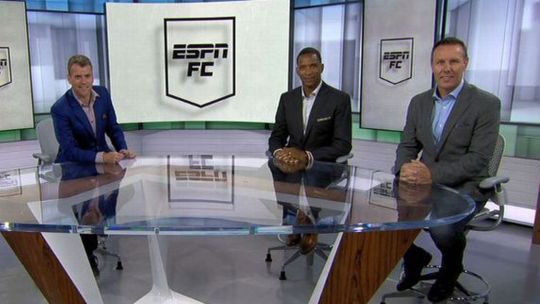
Dan Thomas is joined by Craig Burley, Shaka Hislop and a host of other guests every day as football plots a path through the coronavirus crisis. Stream on ESPN+ (U.S. only).
It’s perhaps little surprise Ozil has yet to be offered any sort of extension, even one on reduced terms. The German midfielder was free to leave last summer, but no club could match his salary. Although he never agitated for a move and has enjoyed a revival under Arteta, it feels as though both Arsenal and Ozil have reached a point where their association is no longer mutually beneficial.
After seven years at the club — eight if Ozil sees out his contract to its conclusion — it will be a landmark moment for the Gunners. Those with intimate knowledge of the player insist his motivation in rejecting a pay cut is not financial — he gives away more than £2m per year to charitable causes — but a question of aspiration, aptitude and intent.
Those questions have been asked of Kroenke for a long time prior to the coronavirus pandemic. They will be asked by prospective new signings, too.
Shkodran Mustafi, David Luiz and Sokratis Papastathopoulos all have deals that expire in 2021. The former has been a divisive figure for some time, while the latter pair are believed to have options in their existing agreements to extend by a further year; all will need addressing soon. Lacazette has two years remaining, giving the club a little more insulation against external market forces, but the French striker has not always looked entirely happy in north London and another tough decision over his future sits on the horizon unless there is a change in mood around the club.
Of course, Arsenal are not alone in facing these challenges. Chelsea were in discussions over a 10% cut for their first-team squad but failed to reach an agreement. Tottenham and Liverpool were forced into reversing their decision to furlough non-playing staff and neither have secured a deferral or cut from their players as yet. At the time of writing, Manchester United insist they are not considering reductions or deferrals, but executive vice chairman Ed Woodward claimed last week that the economic impact would affect their ability to compete in the transfer market when football resumes. And if that is true of a financial behemoth like United, the rest of the Premier League really is in trouble.
The lasting effect of the coronavirus on football is a long way from being known, but as clubs adjust to a future not yet fully formed, a familiar issue plagues Arsenal’s path.
Source link
Tags: Alexandre Lacazette, all blogs, Arsenal, Arsenals, Aubameyang, Beginning, Bukayo Saka, deals, English Premier League, Lacazette, Mesut Özil, Saka, Stress
from WordPress https://ift.tt/3aVmVow via IFTTT
0 notes
Photo

New Post has been published on https://toldnews.com/world/how-to-make-an-avengers-film-in-11-steps/
How to make an Avengers film in 11 steps
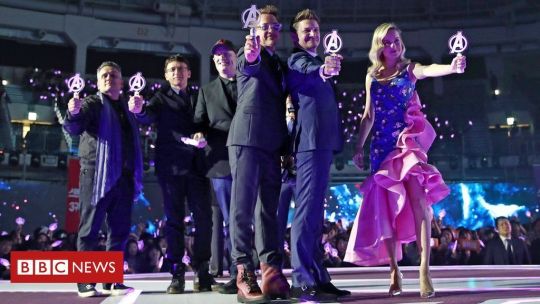
Image copyright Getty Images
Image caption The Avengers cast and crew (L-R): Joe and Anthony Russo, Kevin Feige, Robert Downey Jr, Jeremy Renner and Brie Larson
Avengers: Endgame, the fourth instalment in Marvel’s superhero crossover franchise, made an unprecedented $1.2bn at the box office last weekend.
It’s the biggest three-day haul in movie history; and a testament to the strength of Marvel’s serialised approach to story-telling.
Directors Joe and Anthony Russo said they were “definitely surprised” by the film’s “runaway success” – but also announced they were taking a break from the superhero genre, after making two Captain America and two Avengers films in the space of seven years.
“One of the most important things we learned is that when you’re shooting two of the largest movies ever made, and you’re shooting them back to back… is don’t shoot ’em back to back,” Anthony told BBC News, confirming the duo’s departure.
Joss Whedon experienced similar emotions after writing and directing the series’ first two instalments.
“Why on Earth would I make another Avengers movie? They’re really hard,” he mused on the DVD commentary for Age of Ultron. “It was ill advised. I see that now.”
But Marvel’s Cinematic Universe will continue – with new instalments of Spider-Man and Guardians of the Galaxy already confirmed; and a new configuration of The Avengers almost a certainty.
If you somehow end up in the directors’ chair, how should you prepare? Here are 11 key lessons from the people who made the originals.
This article does not contain spoilers for Avengers: Endgame, but will discuss plot details from the preceding films.
1) Start out on a TV show
Image copyright Fox
Image caption The Russos directed the pilot of Arrested Development, and have referenced the show in both Infinity War and Captain America: Civil War
All three directors of The Avengers made their names in TV. Joss Whedon created Buffy The Vampire Slayer and Firefly; while the Russo brothers worked on cult comedies Community and Arrested Development.
Those experiences were invaluable when it came to wrangling a cast of more than 20 characters, “because they are all ensemble shows,” says Joe Russo.
“Those were shows that had to be executed in 21 minutes, they had to be funny, and they had to have a plot. And sometimes, like in an episode of Community, you’d have 30 speaking parts – so that’s an exercise that certainly trained you in trying to contain as many characters as we do in two hours.”
“We’re drawn to multiple points of view and group dynamics, because we grew up in a very large Italian-American family,” adds Anthony, “so we’ve always loved working with ensembles.”
2) Know the characters inside-out
Image copyright Disney
Image caption The first Avengers film brought together six heroes, now there are more than 20
The joy of the Avengers is seeing how these disparate characters, and the actors who play them, interact.
“There is a natural competition when the leads from two different franchises get together and it plays right into the competition of two heroes getting together – so it is delightful,” observed Infinity War script-writer Chris Markus last year.
“A very compelling element of crossovers is who has primacy. They’re all leaders, they’re all used to leading their own worlds, and once you put them into the same room, who gets to call the shots? That is a notion we revisit several times.”
Still, it’s a challenge to give 23 separate characters a distinct voice in the confines of a three-hour film.
Luckily, there’s an old screenwriting tip that comes in handy: If your characters are well-written, you should know how each of then would react if they accidentally fall into a swimming pool.
“Thor from Infinity War would mess that pool up,” says Anthony. “Whereas Rocket – he’s not exceedingly self-deprecating, so I think I could see him gag and spit. He’d be a little irritated.”
3) Take a lot of toilet breaks
Image copyright Shutterstock
Image caption Even superheroes need the bathroom
Scott Derrickson recently tweeted how he “ran into Joe Russo outside the men’s room,” while he was editing the Doctor Strange film in 2015.
“He pitched me the basic story for both Infinity War and Endgame [and] I told him that if he could make the first movie work, the second movie would be incredible.”
Which begs the question: How long did Joe keep his colleague waiting for the loo?
“I think it was like a 10-minute pitch,” he laughs.
“But the funniest thing is that people are like, ‘Do you guys get together at Marvel all the time and have meetings about the storylines?’
“And the answer is, ‘No, it all happens on the way to the bathroom’. That’s where everyone runs into one another and starts exchanging information.”
In other words, don’t hold it in.
4) Keep the story simple
Image copyright Disney
Image caption The search for the Infinity Stones is the key plot device of Avengers: Infinity War
For all of the acclaim heaped on Infinity War, the plot can be boiled down to three words: “Thanos wants stones”.
“We have so many characters in the movie that we knew if the plot was complicated, it would take too [long] to explain and that would take away from the characters and the action,” said screenwriter Chris Markus on the DVD commentary.
Even the number of Infinity Stones caused a headache, said co-writer Steve McFeely.
“Had we invented the idea of Infinity Stones in a vacuum, I’m sure we would not have decided there were six of them. Six MacGuffins is a lot for one movie.”
To keep things moving, the Russos dictated that every scene “had to do more than one thing”.
So the opening sequence – in which Thanos crushes the Hulk, kills Thor’s brother Loki and steals one of the Infinity Stones – conveys three plot points in two minutes.
“It establishes Hulk’s journey – he’s been defeated and doesn’t particularly want to help [Bruce] Banner over the course of the movie,” explained Anthony Russo.
“It establishes a vengeance story for Thor by taking out his brother, and it establishes the plot for stone collection.”
5) The odds should seem insurmountable
Image copyright Disney
Image caption Just another day at the office
“I wanted to make a movie where being a superhero wasn’t a free pass,” said Joss Whedon, about scripting the first Avengers film in 2012.
“Where things were tough enough that you would be as strong as you could possibly be and still not be enough to deal with what was going on.
“The stakes,” he added, “are always the same.
“The stakes are: You could die.”
6) Acknowledge the ridiculous
Image copyright Disney
Image caption He’s behiiiiind you
When your heroes are up against a sentient robot who’s ripped an entire city off the face of the planet, it pays to acknowledge that everything’s a bit far-fetched.
And so, at the climax of Age of Ultron, Hawkeye takes stock of the situation and says: “We’re fighting an army of robots and I have a bow and arrow. None of this makes sense.”
“I refer to that as ‘inoculation,'” Whedon explained. “He says the thing we’re all thinking, and it plays.”
7) Talk to the animators
Image copyright Disney
Image caption Hulk and Thanos are based on motion-captured performances by Mark Ruffalo and Josh Brolin
The Avengers films are some of the most effects-heavy movies in history, with four major characters – Thanos, Hulk, Rocket and Groot – created by computer animation.
Making them believable is a crucial task, so both Whedon and the Russos started working with artists before the scripts were written.
“Thanos was difficult,” says Joe Russo. “We knew we were sunk if Thanos wasn’t photo-real, so we spent two years doing research and development on Thanos and making sure that he would work correctly.”
For his debut as the Hulk, actor Mark Ruffalo even wrote a letter to the effects team, stressing that his motion-captured performances were only the first stage of creating the character.
“We are all playing this part,” he wrote. “I have taken it as far as I can and you guys have to use what you can and then forget about me and become the Hulk.”
“It was incredibly inspiring to the animators,” recalled Whedon, who set aside a day to explain how the movie portrayed two different aspects of the green-skinned monster: “The one Bruce Banner becomes unwittingly and the one he decides to be”.
“What I found out later was that most of them – in fact all of them – had not been able to see the script, so they were just animating things in a vacuum,” he said. “So it was incredibly productive.”
8) Always put the raccoon on a chair*
Image copyright Disney
Image caption Size isn’t everything…
Have you ever noticed that Rocket – the CGI raccoon played by Bradley Cooper – is almost always standing on a chair?
“That’s a great point,” says Anthony. “When you’re dealing with characters of radically different sizes, it presents a lot of framing challenges.
“You start to learn tricks in blocking [staging the scene] to keep everyone in the same relative plane, so you can actually shoot them.”
(* or a table)
9) Ban t-shirts
When we first meet Scarlett Johansson’s Black Widow in Avengers Assemble, she’s tied to a chair, barefoot and in a vest top, apparently being interrogated by shadowy Russian forces.
Of course, she breaks free in spectacular fashion… but her outfit made it one of the hardest stunt scenes to choreograph.
“Whenever you say ‘she has no sleeves’ to your stunt co-ordinator he cries man tears,” Joss Whedon noted afterwards.
“It’s very difficult to do a lot of these things if you can’t pad up the knees and elbows.”
10) Embrace the darkness
Image copyright Getty Images
Image caption Joss Whedon clashed with Marvel during the making of Age Of Ultron
Making these films is “incredibly physically demanding,” says Joe Russo, and there will inevitably be dark days.
“When you start out, it’s all perfect in your head,” Whedon told BBC News in 2015, “and when you work with the actors, it gets better.
“Then at some point you’ve been editing for so long you start thinking. ‘Who am I? What’s happening?’ and you forget why you ever showed up, and what you’re trying to say. And you despair. It’s a very bleak experience.
11) Emotion > action
Image copyright Disney
Image caption Thor is sad
Adding character beats to action sequences has been Joss Whedon’s calling card since Buffy – and he pulls it off perfectly in Age Of Ultron’s climactic battle, where Hawkeye stops whaling on the bad guys to discuss home improvements.
“You know what I need to do? The dining room,” he tells Black Widow. “If I knock out that east wall, it’ll make a nice work space… What do you think?”
“That sequence is, for me, the reason I show up,” Whedon said in the commentary. “Where two people in the apocalypse are talking about re-doing the dining room, that says more about their relationship than anything else I could have done.”
The Infinity War team made a similar decision. Their film doesn’t end with a battle but the emotional fallout of Thanos’s “snap” – scenes that left some viewers in tears.
So what will they feel when they walk out of Endgame?
“Catharsis,” says Joe Russo.
“We realise how impactful the Infinity War ending was,” adds his brother.
“We saw how difficult it was for many people and that’s something that we really respect. So we were very committed to paying off that kind of a story.”
Follow us on Facebook, on Twitter @BBCNewsEnts, or on Instagram at Toldnewsnewsents. If you have a story suggestion email [email protected].
http://platform.twitter.com/widgets.jshttps://platform.instagram.com/en_US/embeds.js
0 notes